When we arrived at the Wat Rong Suea Ten temple in Chiang Rai, I couldn’t believe my eyes. Yes, I knew we would visit a temple called the “Blue Temple,” but nothing could prepare me for what I saw here. I could hardly wait to jump out of the minibus and start exploring and taking photos. Most likely I just have a weakness for kitsch, but to me, this was fantastic!!!
First, I went back to the street to capture what you first see when approaching the temple and these were two imposing figures “guarding” the entrance. A bit further, the main structure of this smallish temple comes into view.
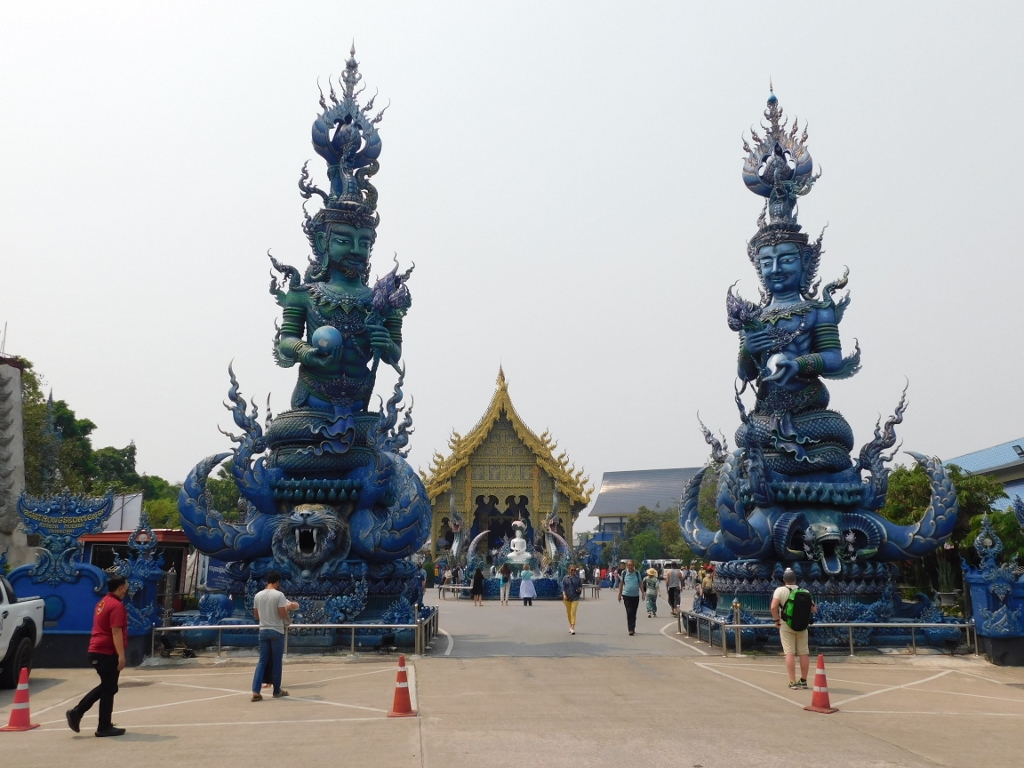 Wat Rong Suea Ten or the Blue Temple
Wat Rong Suea Ten or the Blue Temple
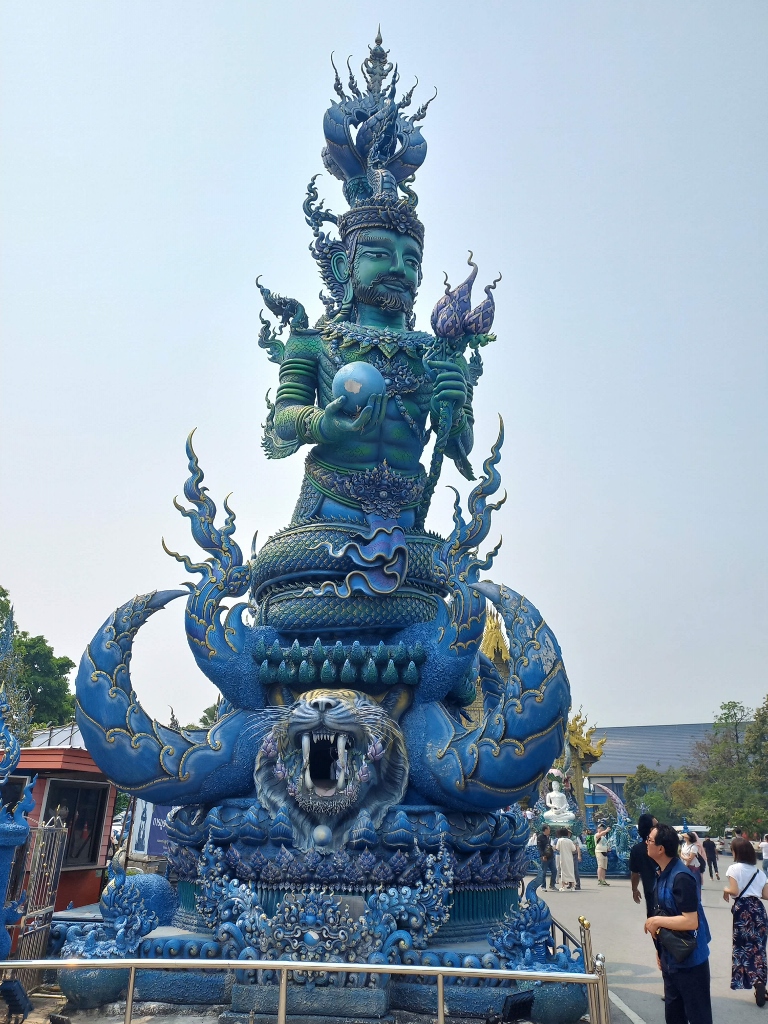 Wat Rong Suea Ten, a detail
Wat Rong Suea Ten, a detail
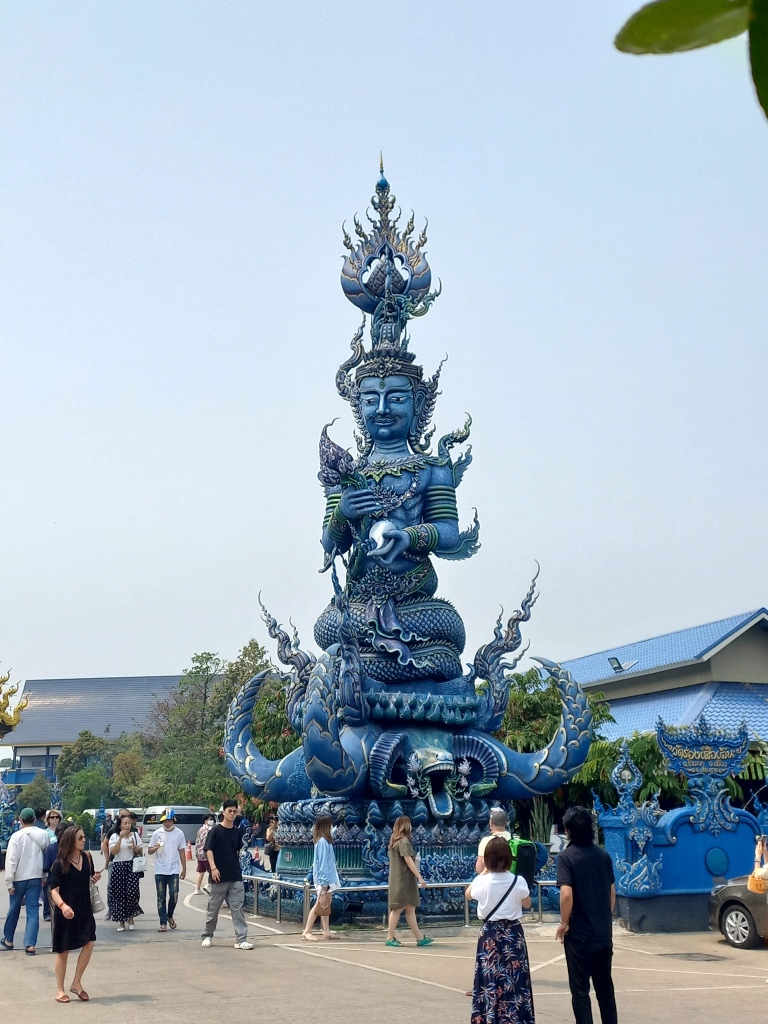 Wat Rong Suea Ten, a detail
Wat Rong Suea Ten, a detail
Then I circled around these figures at the front to see details, such as the entrance to the interior of the figures or the rich decoration adorning both of them.
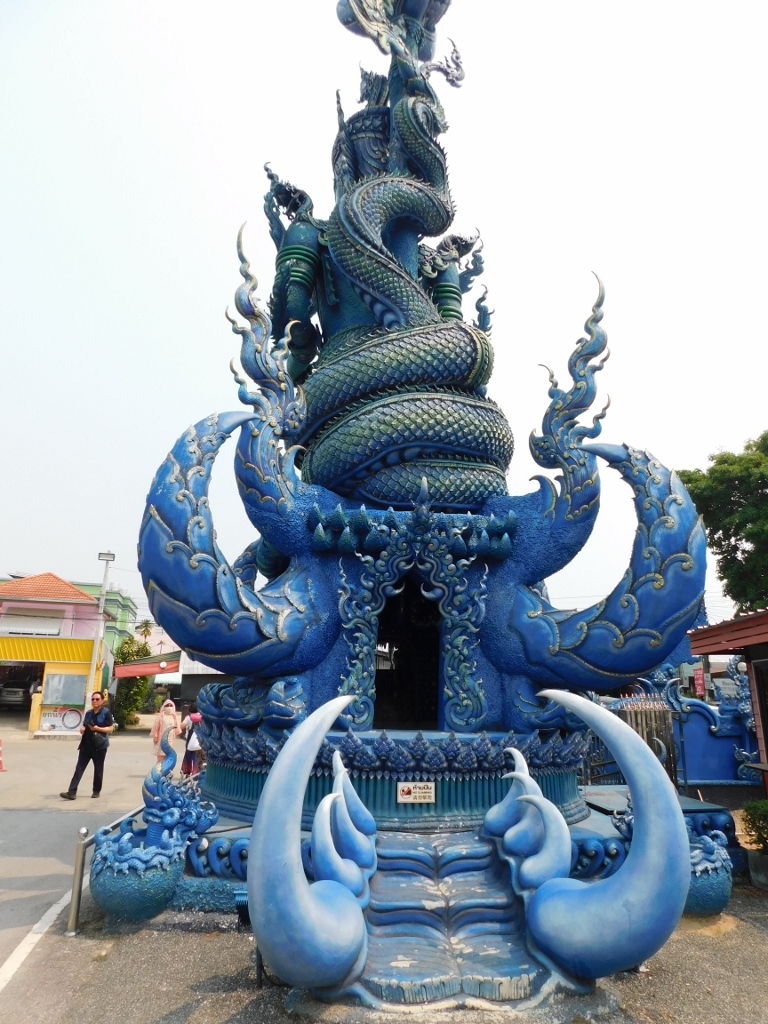 Wat Rong Suea Ten, a detail
Wat Rong Suea Ten, a detail
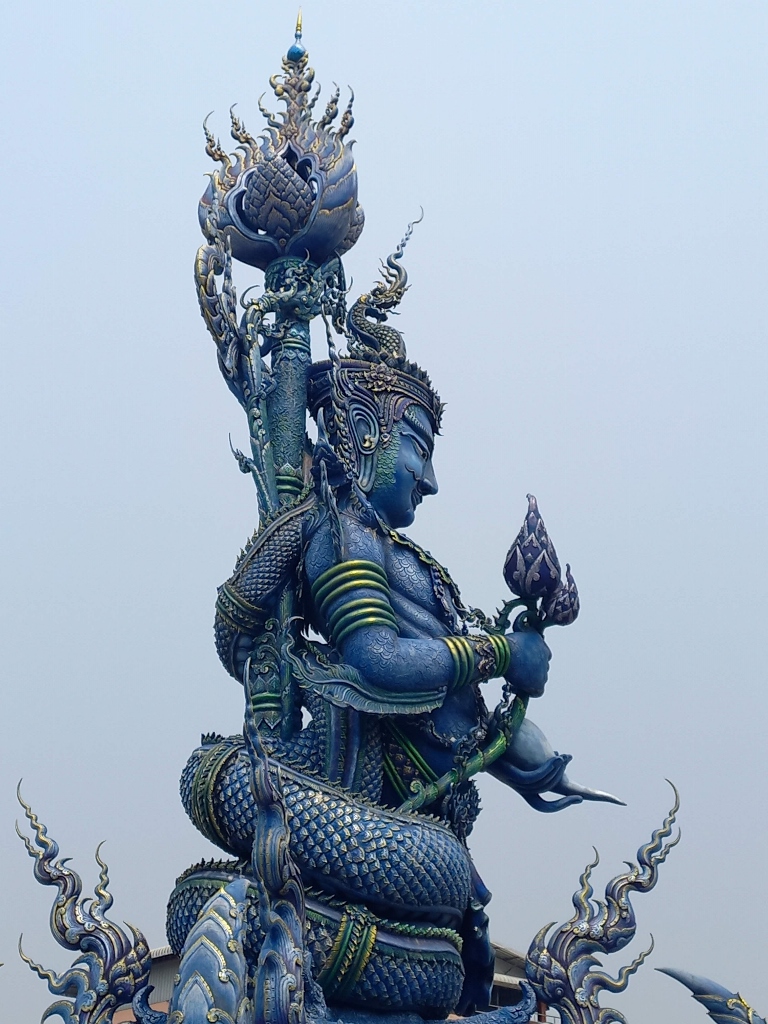 Wat Rong Suea Ten, a detail
Wat Rong Suea Ten, a detail
In front of the main structure, there is a plaza with a fountain in its centre, while to the side, there is a shrine, but everything is gleaming incredibly with the blue colour!
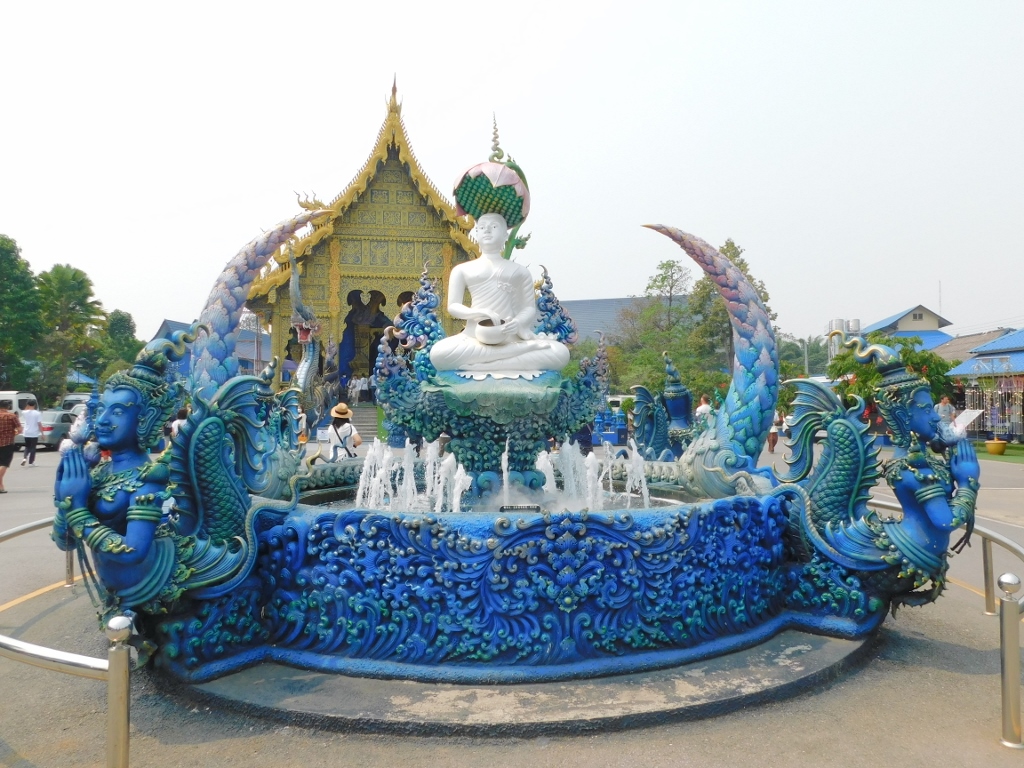 Wat Rong Suea Ten, a detail
Wat Rong Suea Ten, a detail
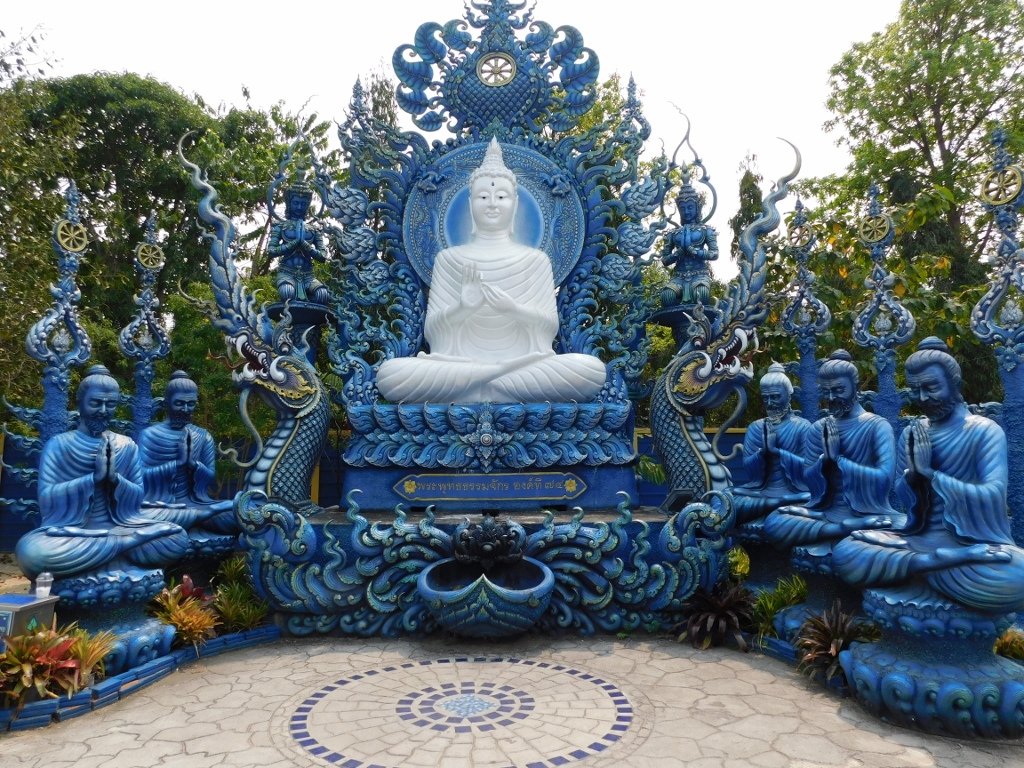 Wat Rong Suea Ten, a detail
Wat Rong Suea Ten, a detail
In the past, at this location, there was an old abandoned temple and then in 1996, people from the local community decided to change that and build a new temple here. However, the construction did not begin until 2005, while the final project was done by a local artist who had actually learned from his colleague responsible for the White Temple, which I wrote about in the previous part of the travel stories.
The main structure within the temple was completed only in 2016 and like everything else I saw here, it is decorated to an absolutely incredible degree, with the dominant blue colour and many golden elements. Once again, to emphasise, as in the case of the White Temple, no matter how it may look at first and every subsequent glance, this is not an amusement park but a religious site. This temple, just like the White Temple, clearly illustrates how contemporary Thailand successfully merges and intertwines artistic expression, religious function and spiritual aspects.
I don’t have much more to write about this now, so here is a series of photos where I wanted to preserve memories of various details and viewing angles.
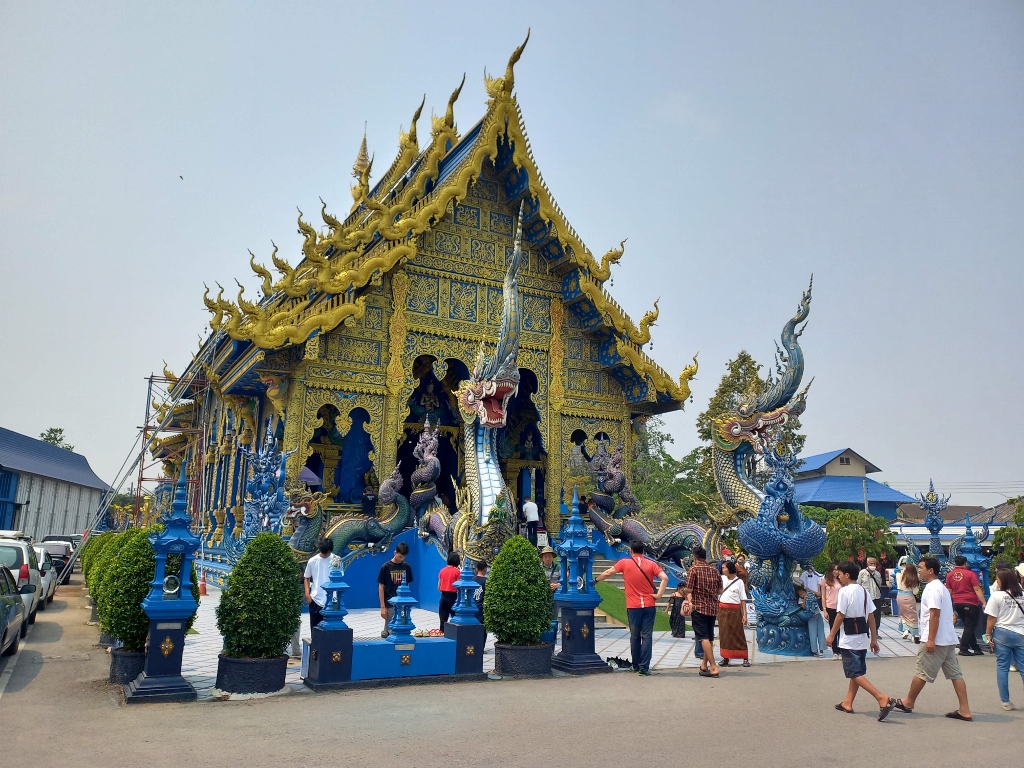 Wat Rong Suea Ten, a detail
Wat Rong Suea Ten, a detail
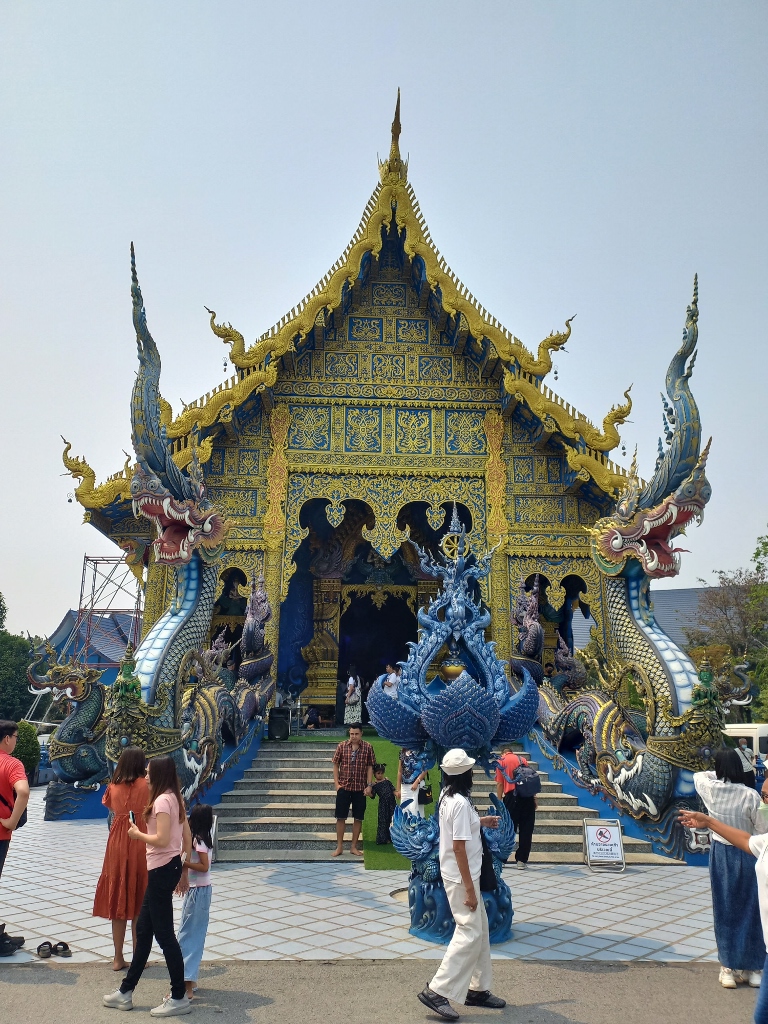 Wat Rong Suea Ten, a detail
Wat Rong Suea Ten, a detail
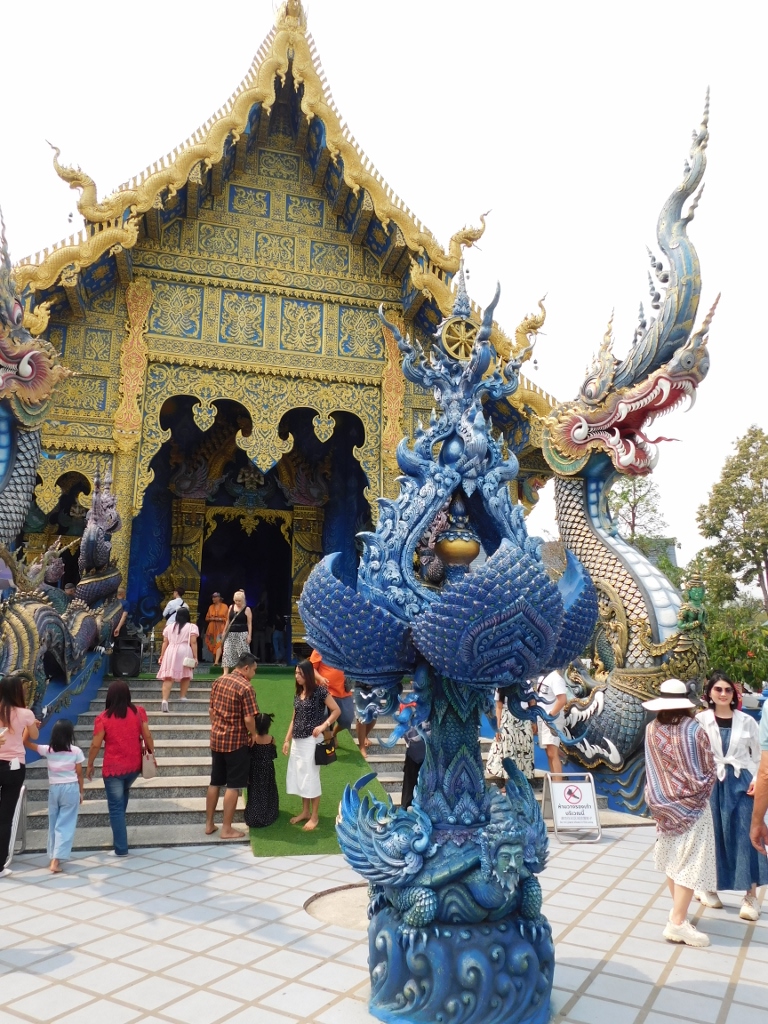 Wat Rong Suea Ten, a detail
Wat Rong Suea Ten, a detail
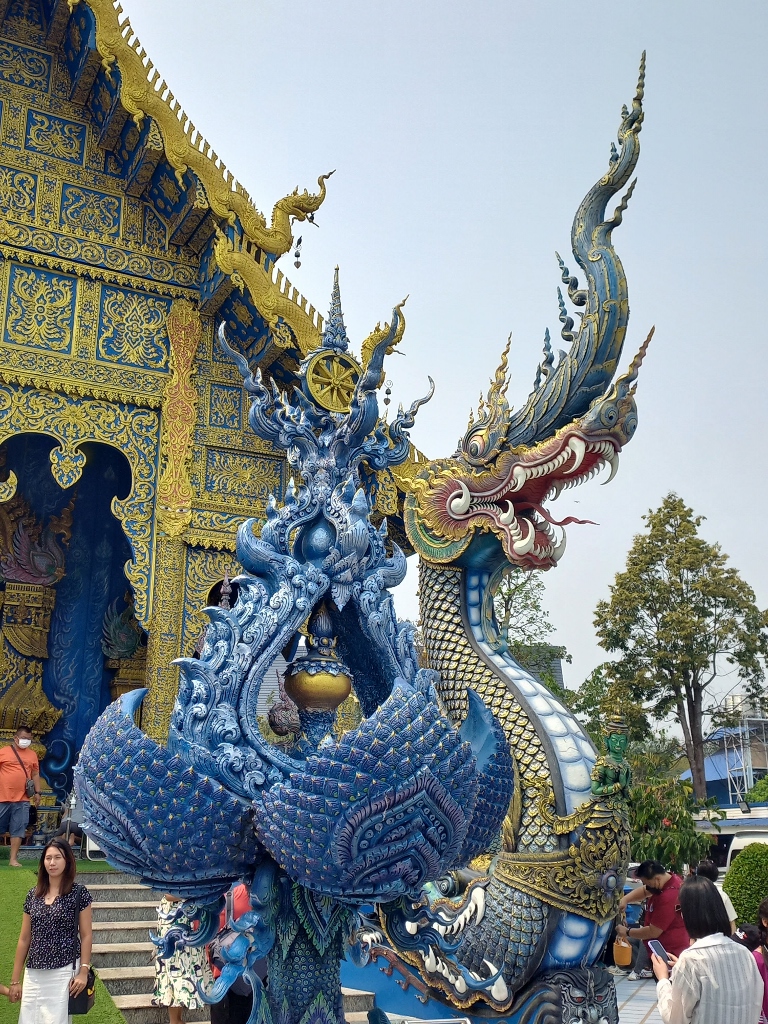 Wat Rong Suea Ten, a detail
Wat Rong Suea Ten, a detail
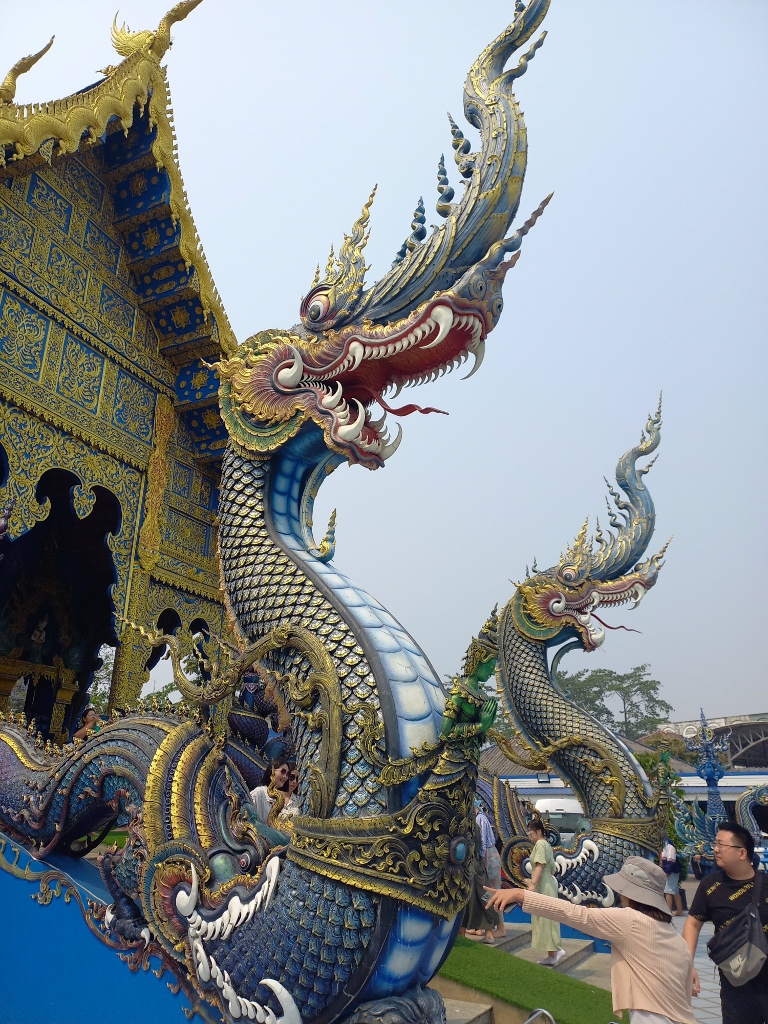 Wat Rong Suea Ten, a detail
Wat Rong Suea Ten, a detail
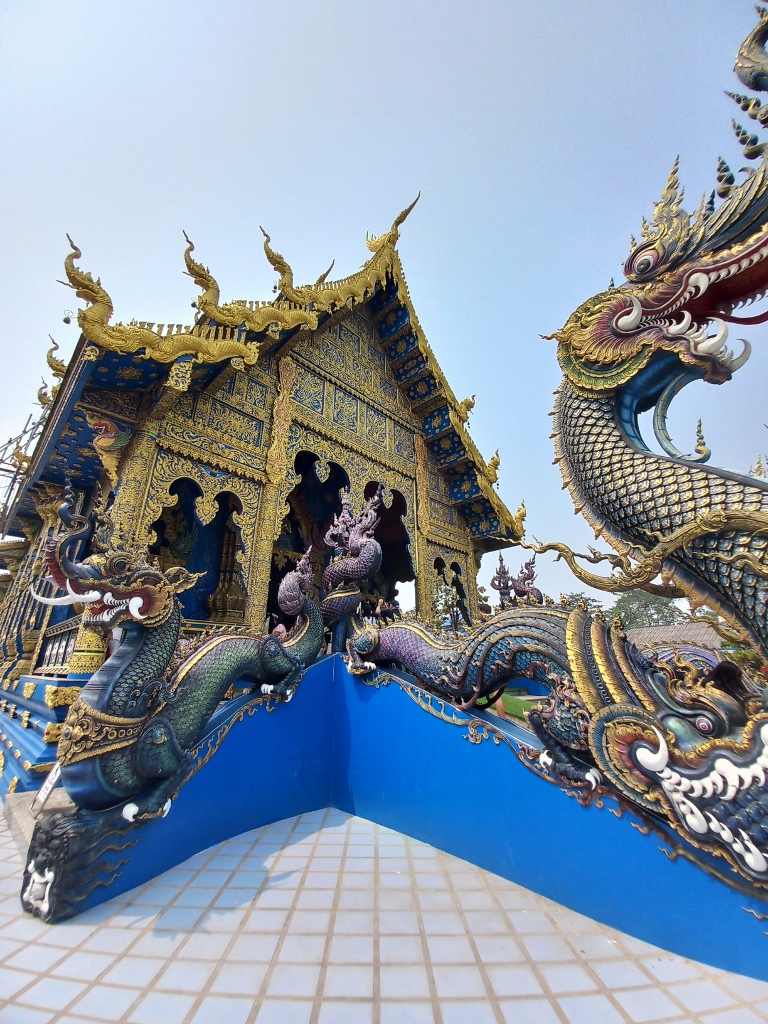 Wat Rong Suea Ten, a detail
Wat Rong Suea Ten, a detail
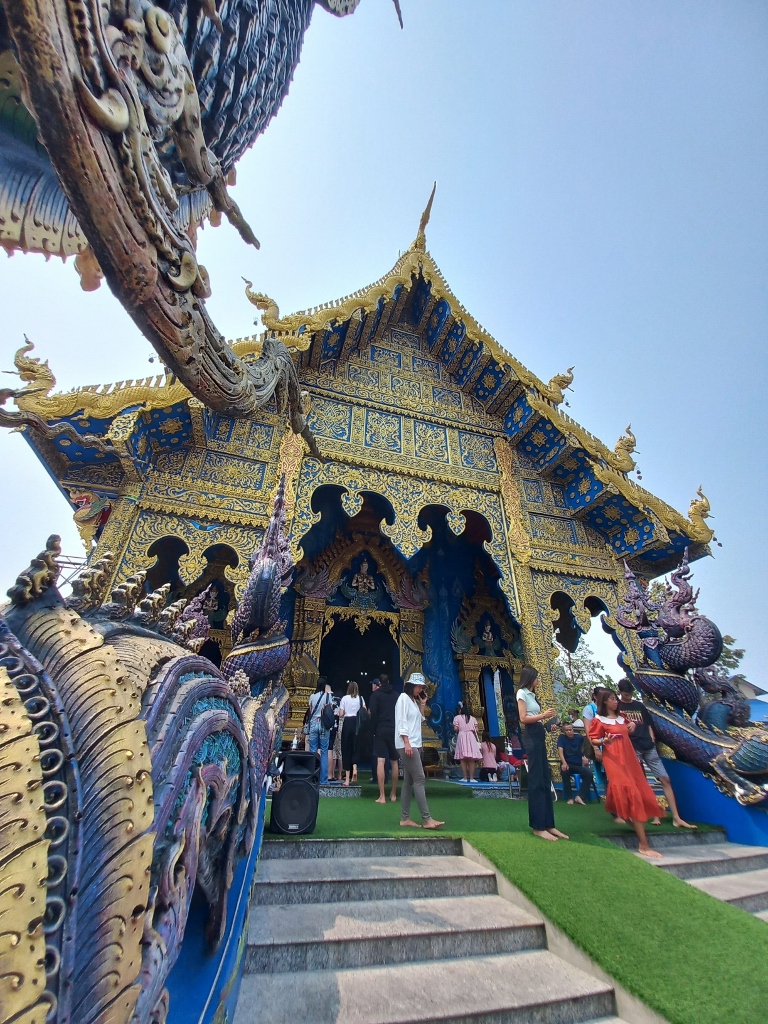 Wat Rong Suea Ten, a detail
Wat Rong Suea Ten, a detail
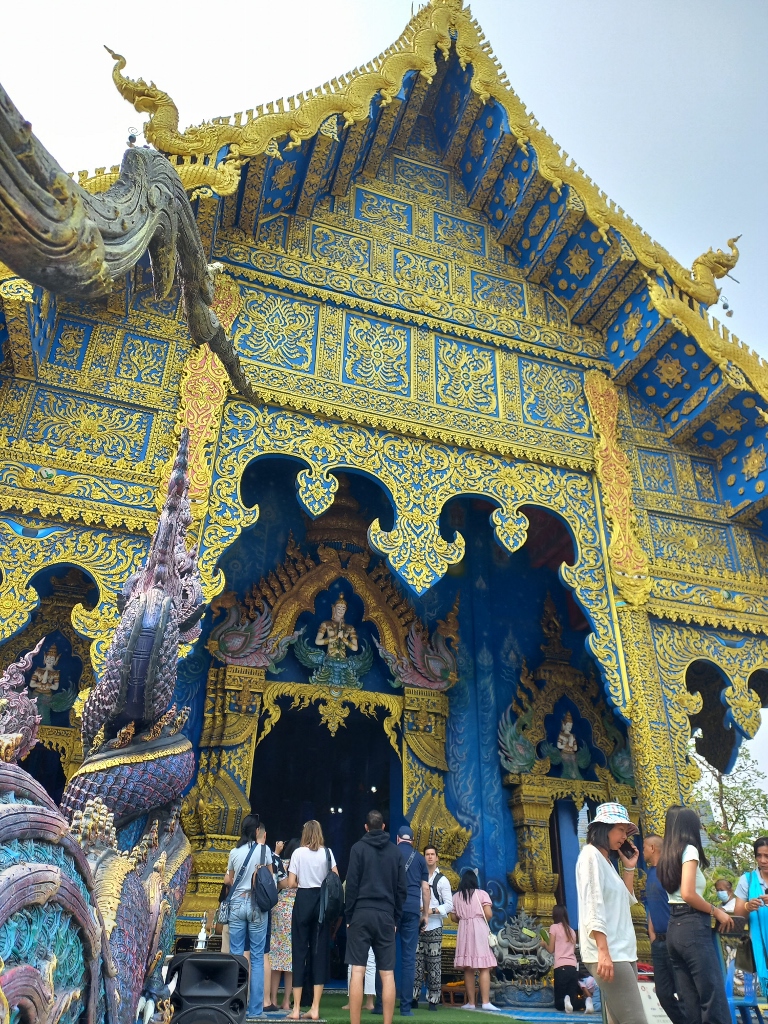 Wat Rong Suea Ten, a detail
Wat Rong Suea Ten, a detail
And as if there wasn’t enough blue from the outside – there was the interior of the main structure. Some of these photos may seem repetitive, but still each one of them offers a different detail or perspective.
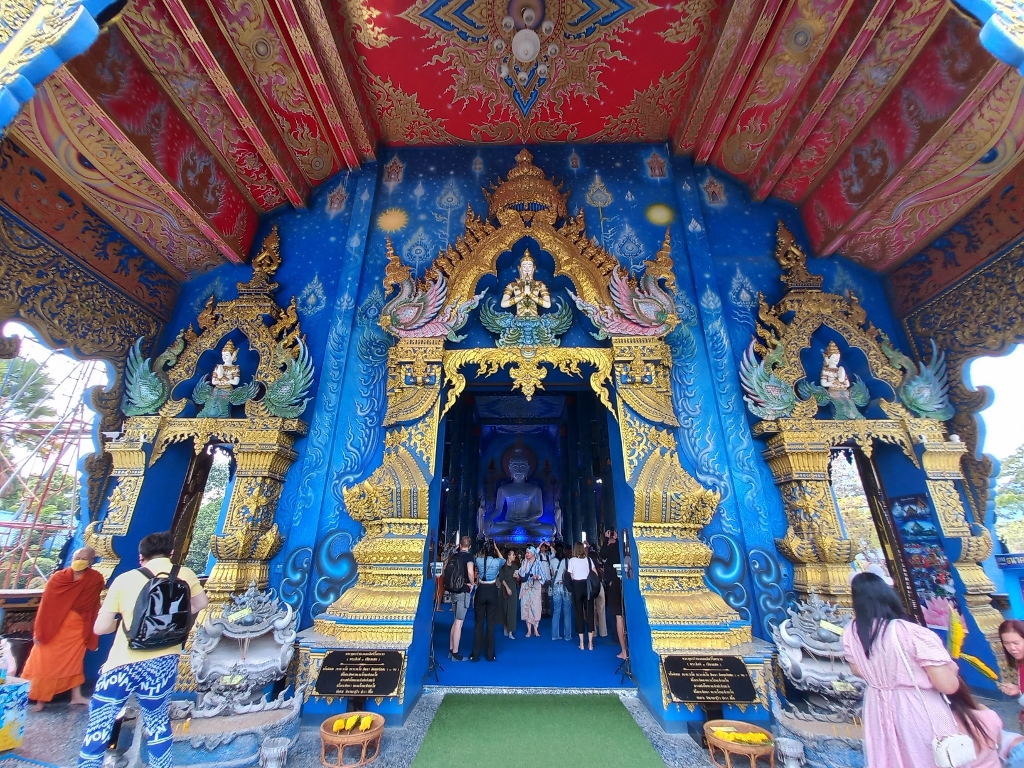 Wat Rong Suea Ten, a detail
Wat Rong Suea Ten, a detail
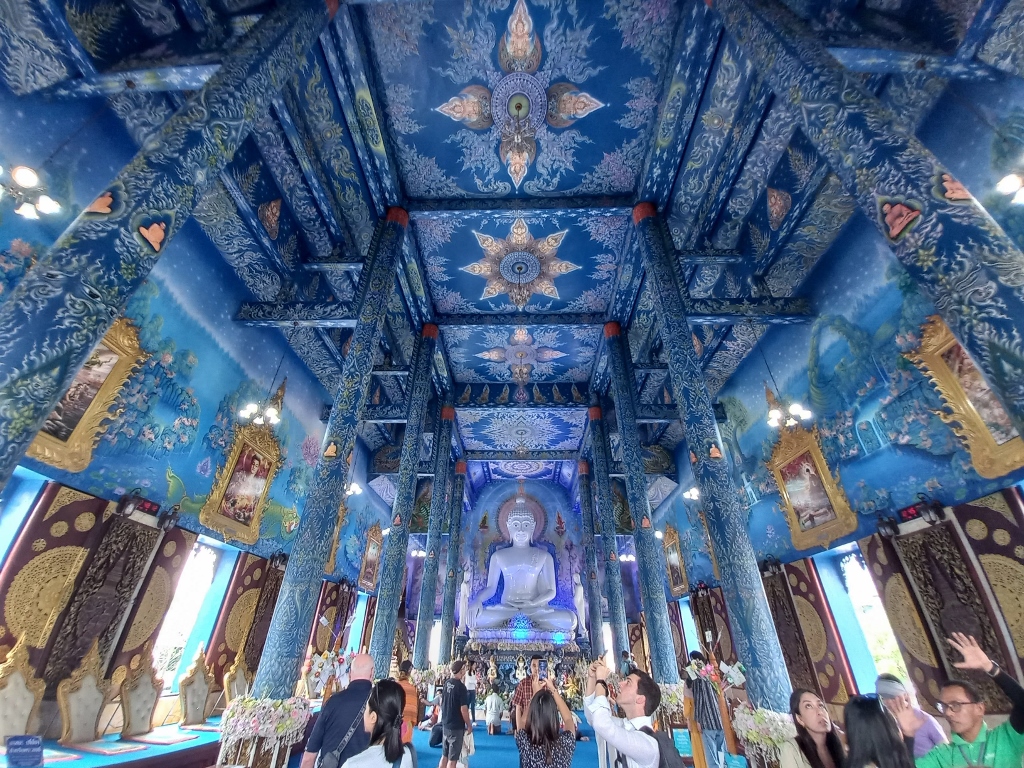 Wat Rong Suea Ten, a detail
Wat Rong Suea Ten, a detail
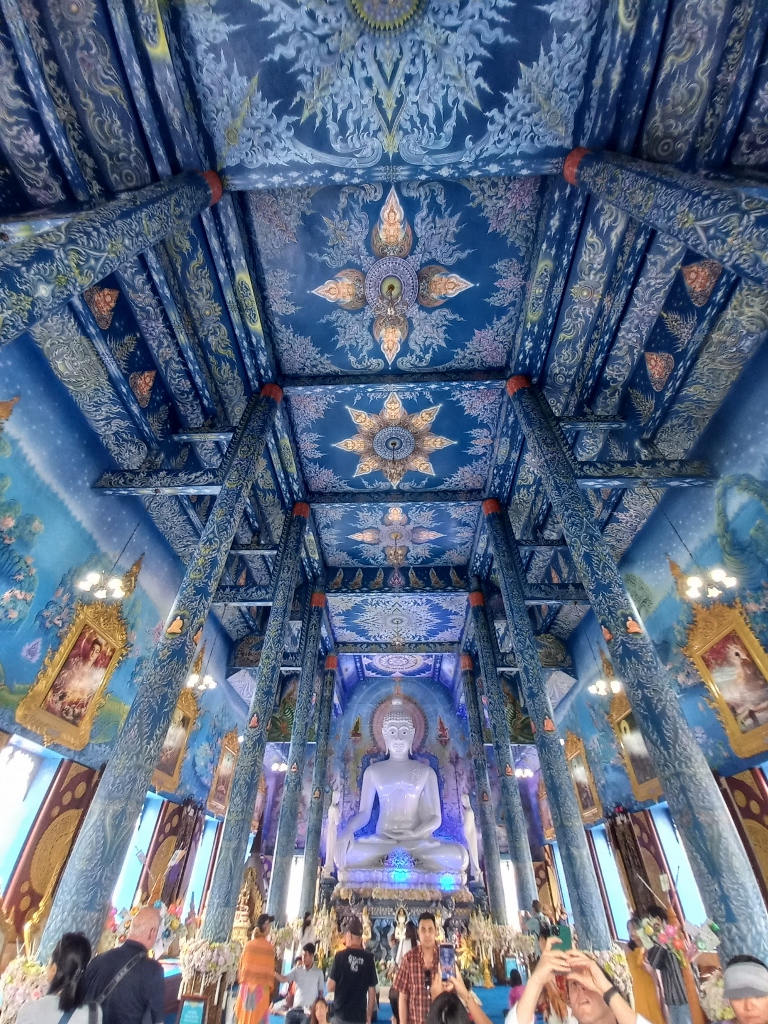 Wat Rong Suea Ten, a detail
Wat Rong Suea Ten, a detail
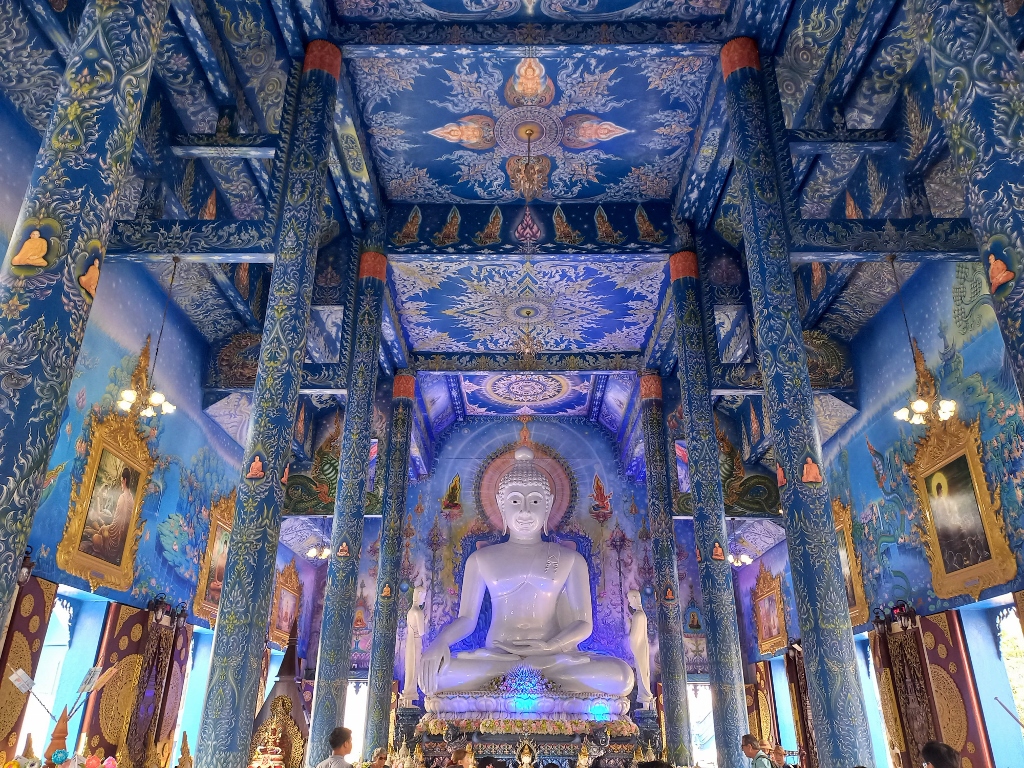 Wat Rong Suea Ten, a detail
Wat Rong Suea Ten, a detail
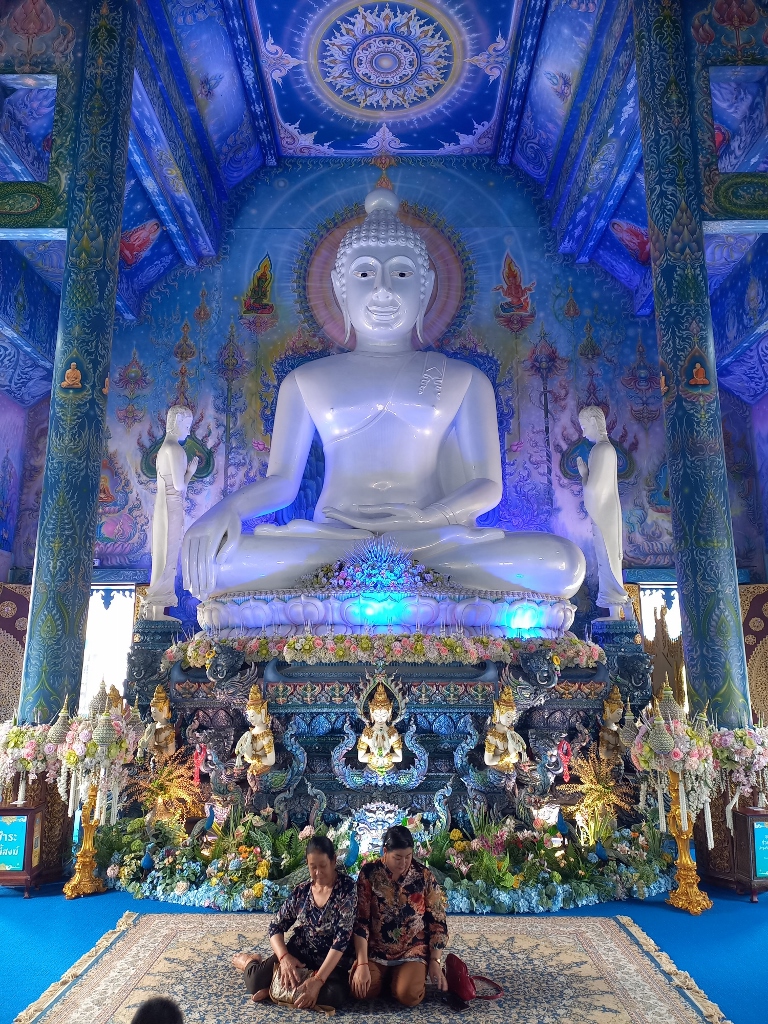 Wat Rong Suea Ten, a detail
Wat Rong Suea Ten, a detail
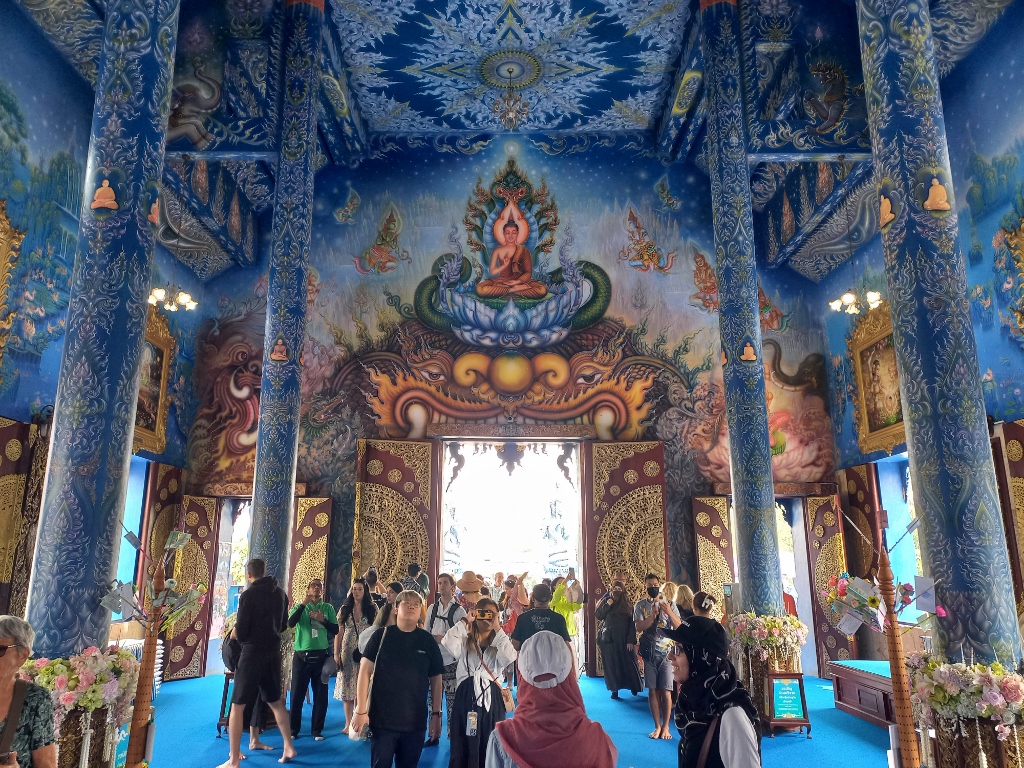 Wat Rong Suea Ten, a detail
Wat Rong Suea Ten, a detail
After exiting the main structure within the temple, I started walking around it in order to reach the rear part of this small temple complex.
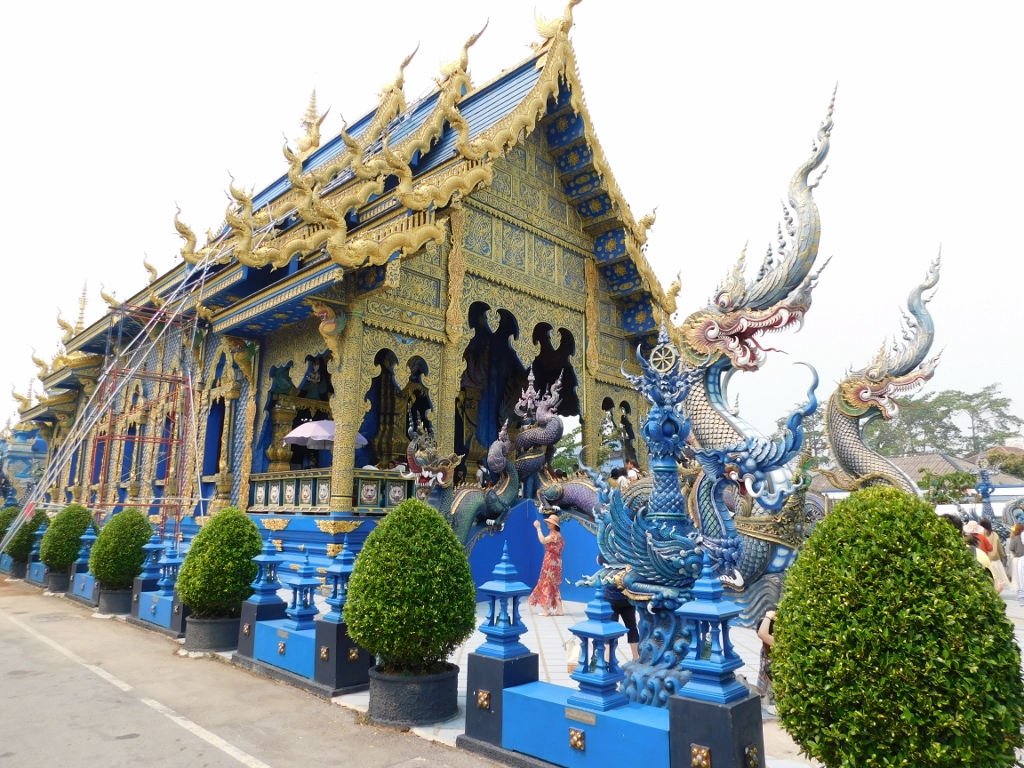 Wat Rong Suea Ten, a detail
Wat Rong Suea Ten, a detail
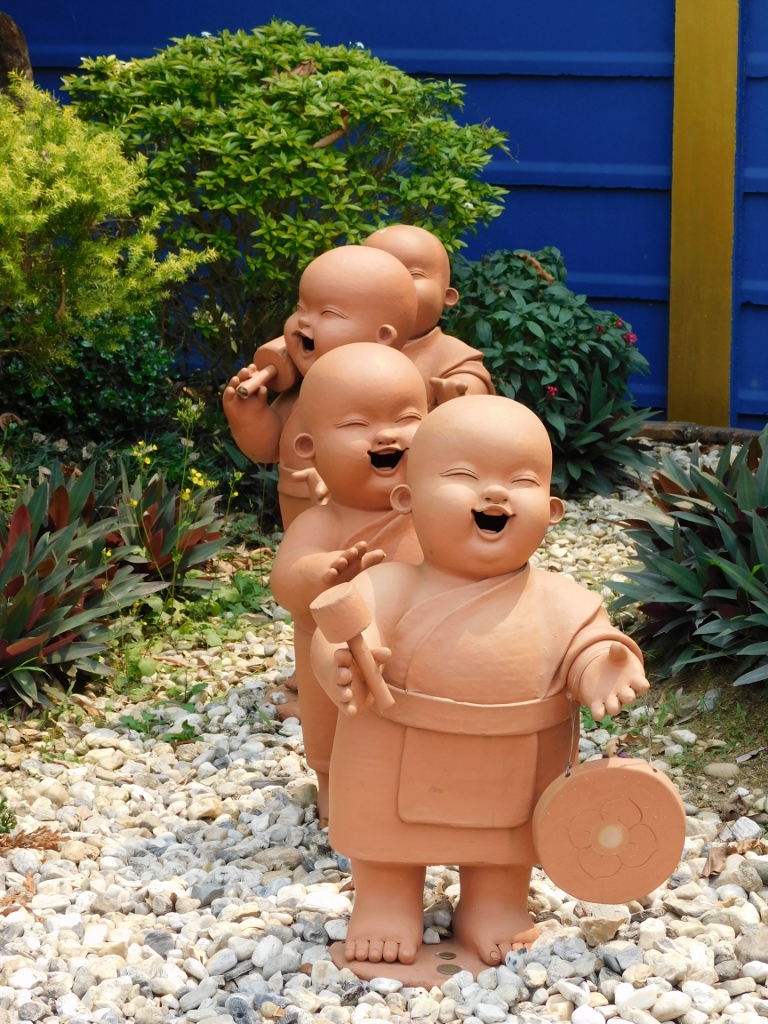 Wat Rong Suea Ten, a detail
Wat Rong Suea Ten, a detail
Then I reached the rear part, where you can see the back facade of the main structure. There is a large statue of a standing Buddha, while opposite him there is a chedi.
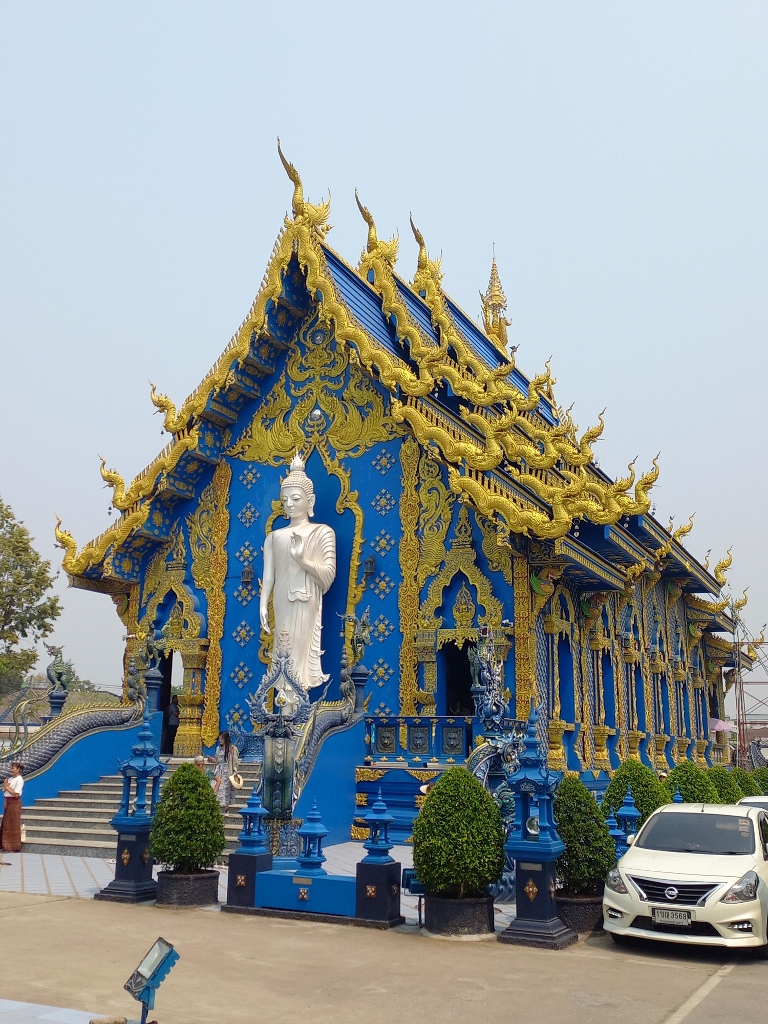 Wat Rong Suea Ten, a detail
Wat Rong Suea Ten, a detail
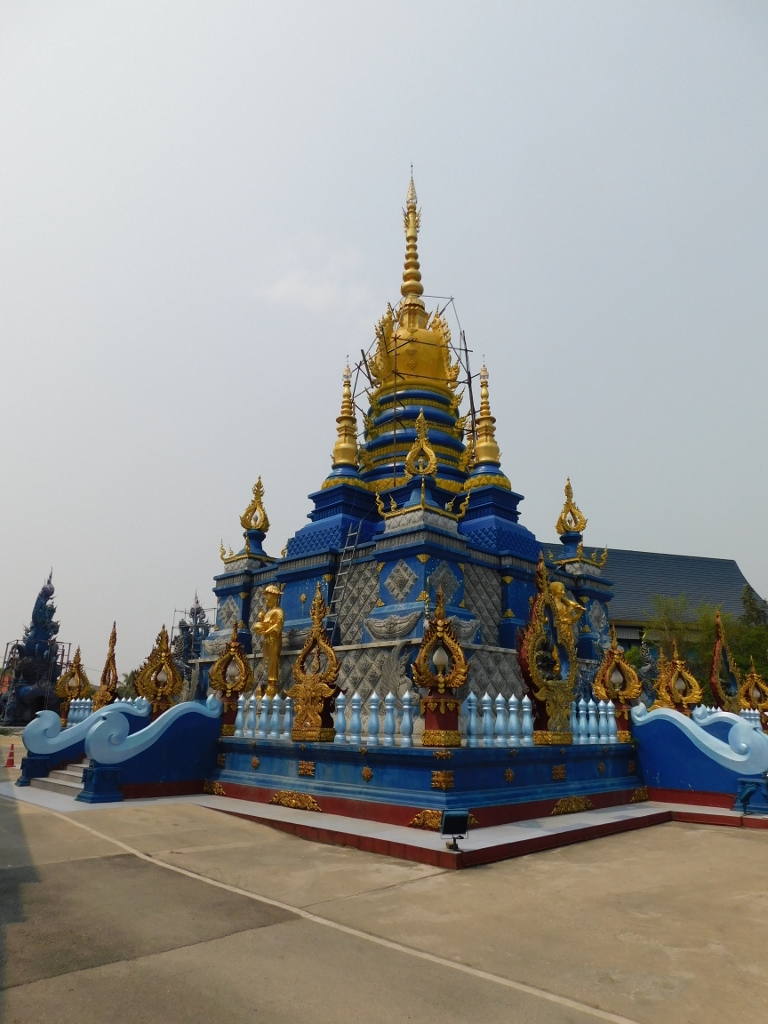 Wat Rong Suea Ten, a detail
Wat Rong Suea Ten, a detail
Behind the chedi, there is also a large passage for vehicles, with the “guardians” still in the construction phase, although their details are entirely extraordinary. Again, I first went out to the street to photograph all of this from a distance and then I focused on the details.
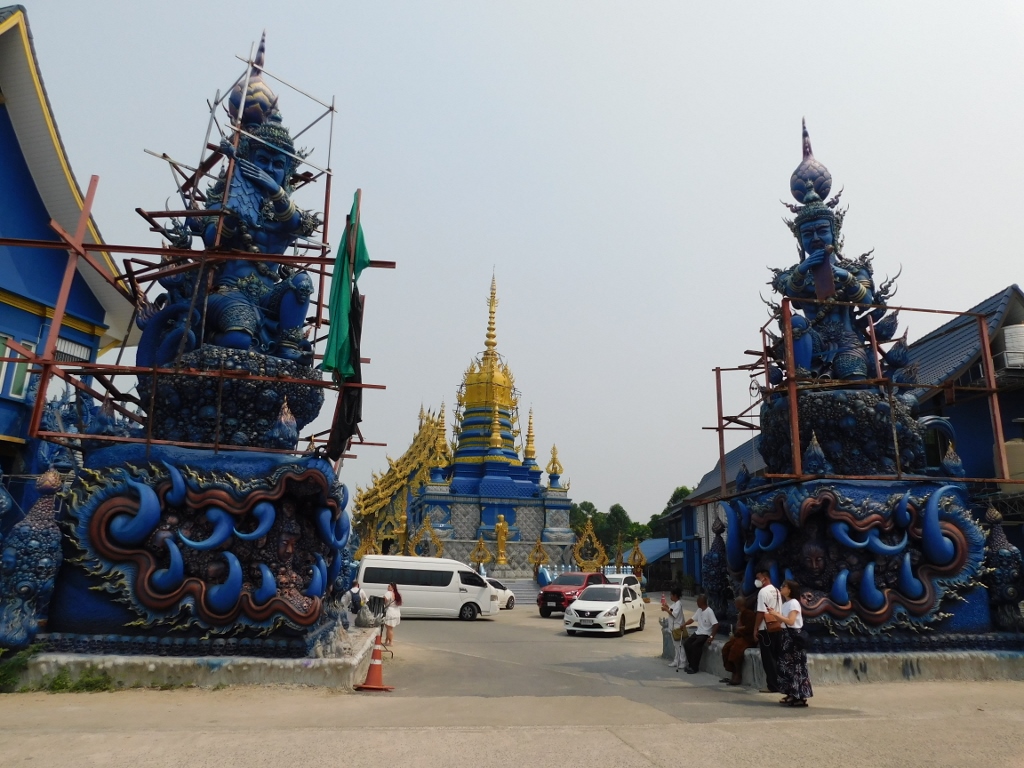 Wat Rong Suea Ten, a detail
Wat Rong Suea Ten, a detail
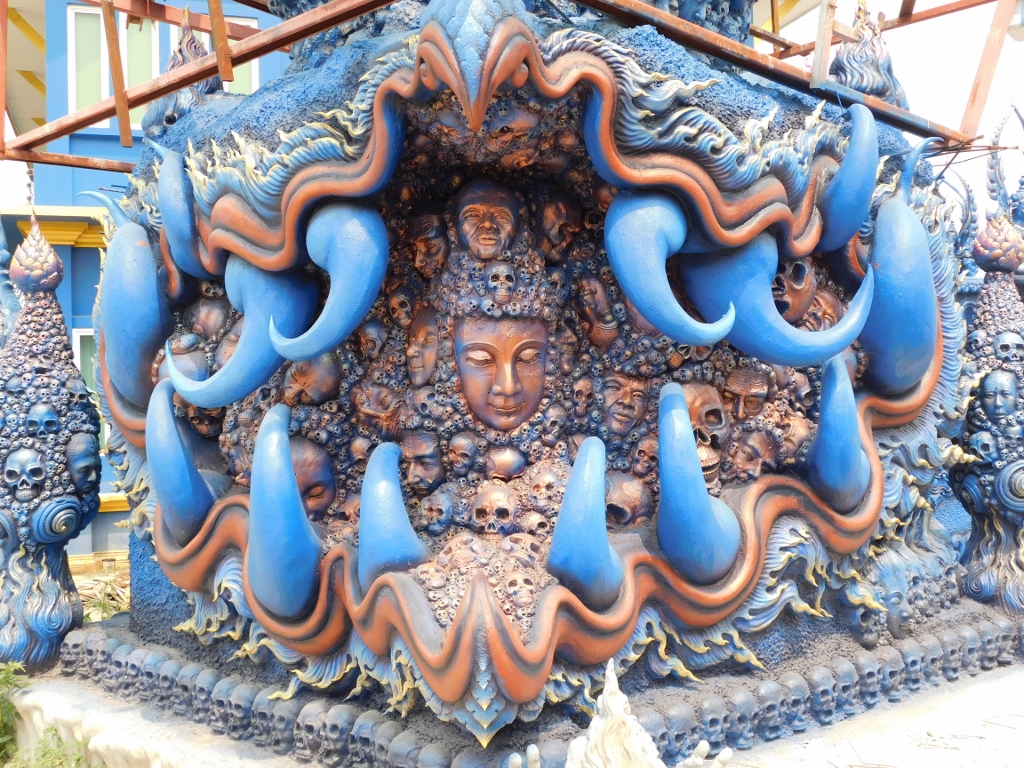 Wat Rong Suea Ten, a detail
Wat Rong Suea Ten, a detail
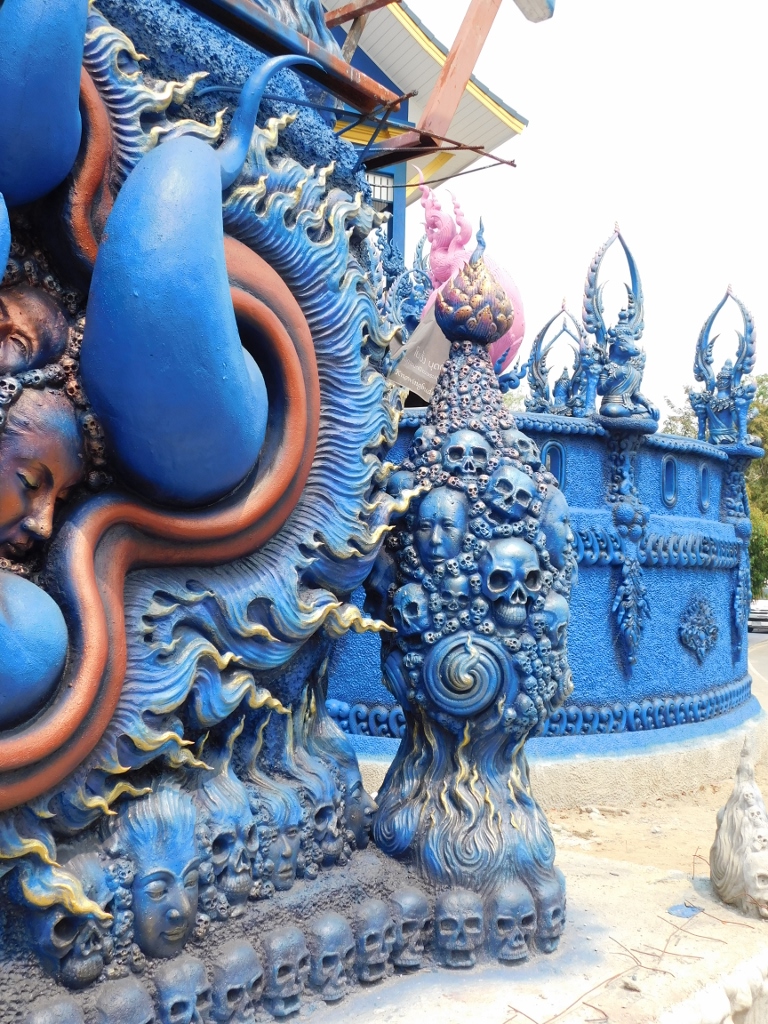 Wat Rong Suea Ten, a detail
Wat Rong Suea Ten, a detail
On the way back to the front of the temple, I first climbed onto the terrace around the chedi, where I took photos of the details of the main structure. Then I had to start making my way back to the minibus because we had less free time here.
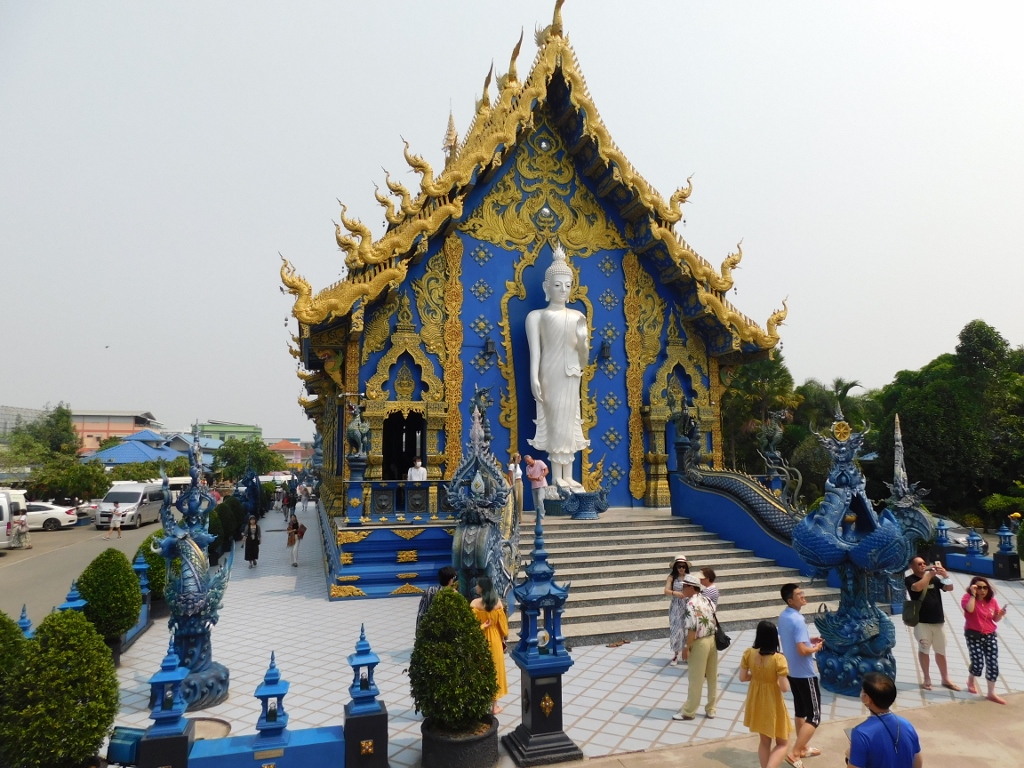 Wat Rong Suea Ten, a detail
Wat Rong Suea Ten, a detail
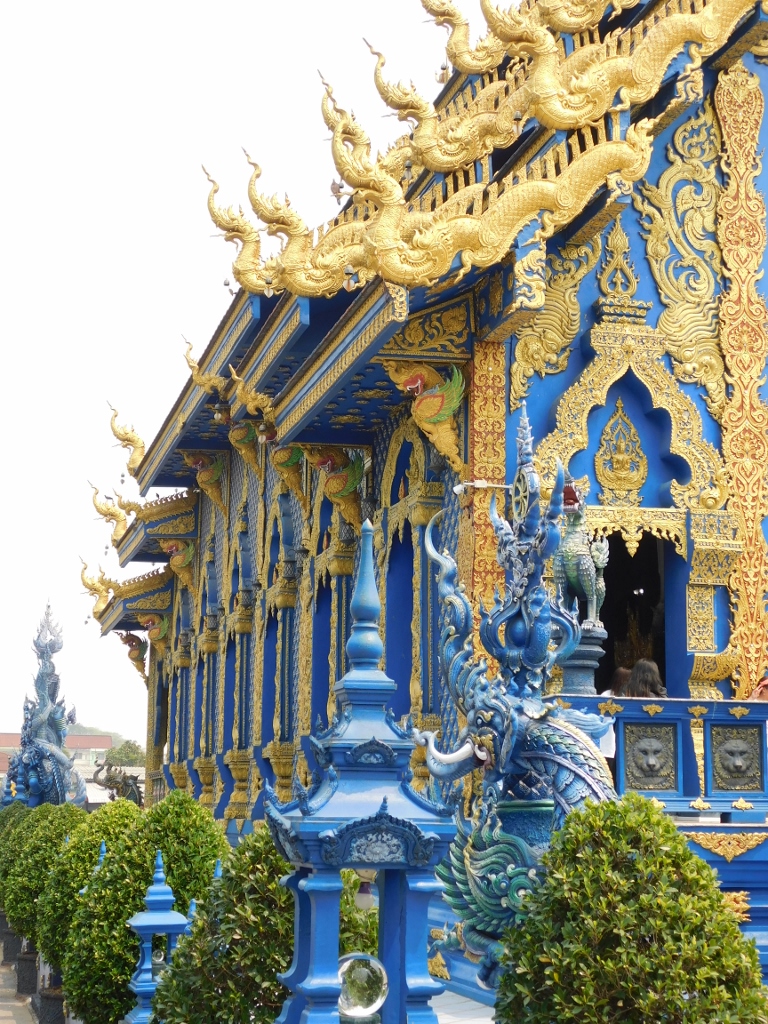 Wat Rong Suea Ten, a detail
Wat Rong Suea Ten, a detail
The minibus was parked right next to the main structure and there was a modern representation of Garuda nearby. Garuda is a popular Hindu deity, a mount of god Vishnu, but in Buddhism, the term refers to birds with golden wings mentioned in ancient Buddhist texts.
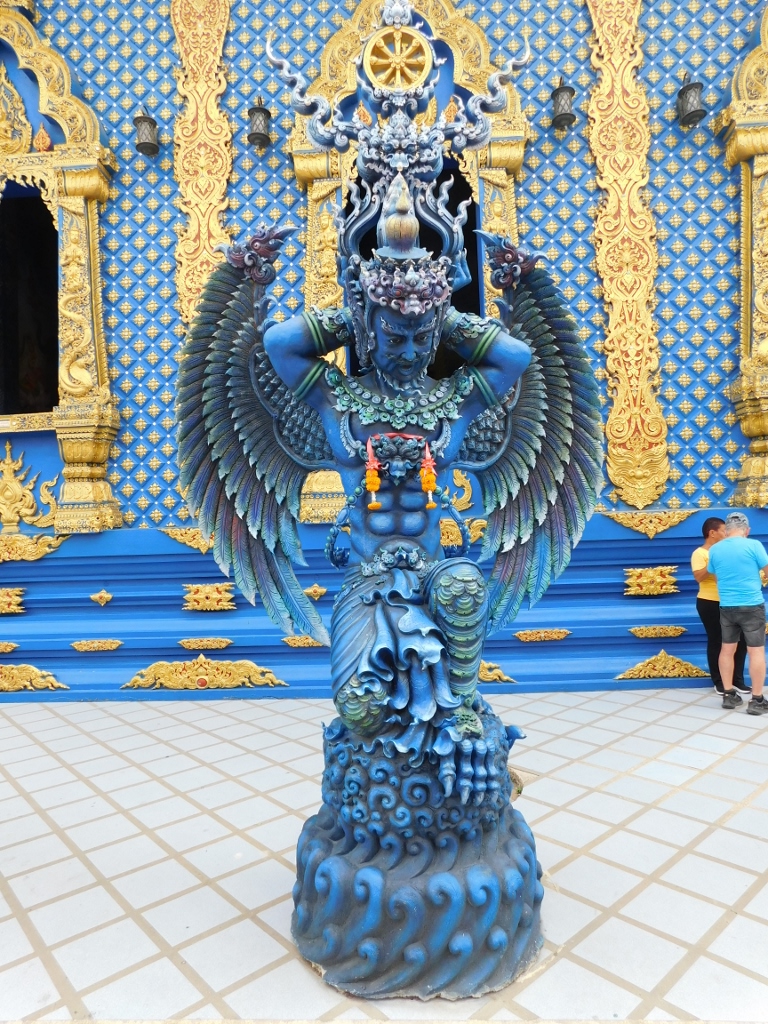 Wat Rong Suea Ten, a detail
Wat Rong Suea Ten, a detail
And for those who didn’t have enough of blue colour, there was the local ice cream, which is extremely popular. Why? Well, because it’s also blue! I don’t think there was anyone who didn’t buy it.
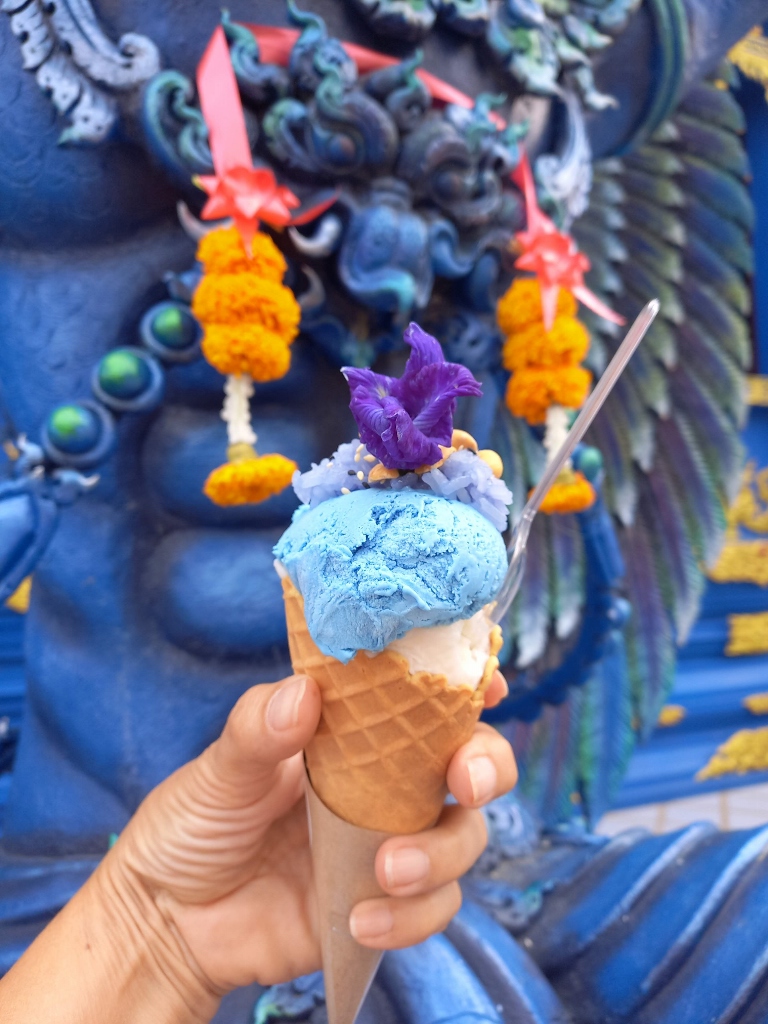 Blue ice-cream at the Blue Temple
Blue ice-cream at the Blue Temple
The day trip I went on this day was advertised as a visit to three temples. These places certainly have their original names, but probably due to foreign tourists, their adapted names are most commonly used in brochures: White Temple, Blue Temple and – Black Temple.
Now, this third one, the Black Temple, that was our next destination, is not actually a temple at all; it is a museum called The Baandam Museum, located less than 10 km further north from the Blue Temple.
This “temple,” too, is an artistic project that opened to the public just a few years ago. It would be more accurate to call it an open-air museum situated within a park. However, due to its dominant dark colour and for the tourist marketing purposes, it is most commonly referred to as the Black Temple. On the other hand, the museum’s actual name, “Baandam,” means Black House and this term is also commonly used for the place.
This place was created by the renowned Thai contemporary artist Thawan Duchanee (1939-2014), who gained both national and international acclaim as a painter, sculptor and architect. In 2001, he was proclaimed in Thailand a national artist in the field of visual arts (painting).
At this site where the Museum of Folk Arts stands today, Thawan Duchanee erected around 40 mostly smaller dark houses made of wood and other materials. Most of the structures were built in the traditional style of northern Thailand, but there are a few that in every aspect belong to contemporary architecture. Some of these houses showcase parts of Thawan’s collections of paintings and sculptures, as well as animal bones and skins, horns and many other ordinary or often unusual objects from around the world. On the other hand, some houses are used to display the art and architecture of the Lan Na region and Southeast Asia in general.
All of this takes on a completely different meaning when visitors come here and start exploring. Each structure has its name or at least a brief description.
First, there is the Sanctuary and the Main Sanctuary Hall.
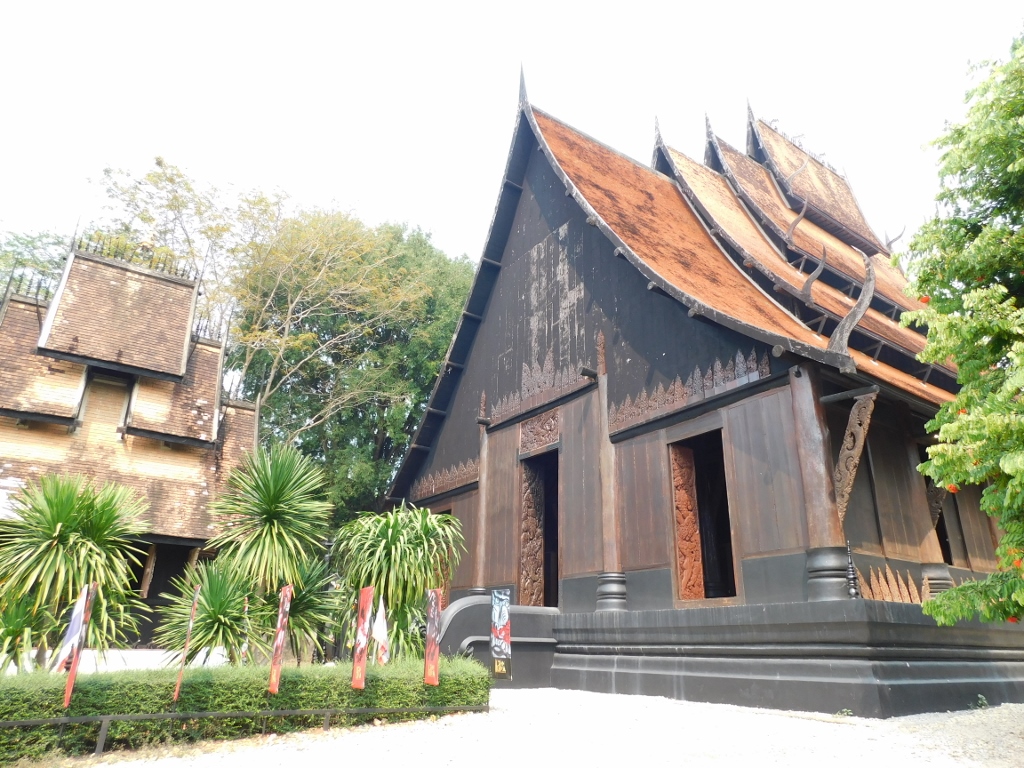 The Baandam Museum
The Baandam Museum
I first climbed the stairs of the Main Sanctuary to take a photo of the Sanctuary and then I went back to take another shot of the entrance to the largest structure within the museum before entering and starting my detailed sightseeing.
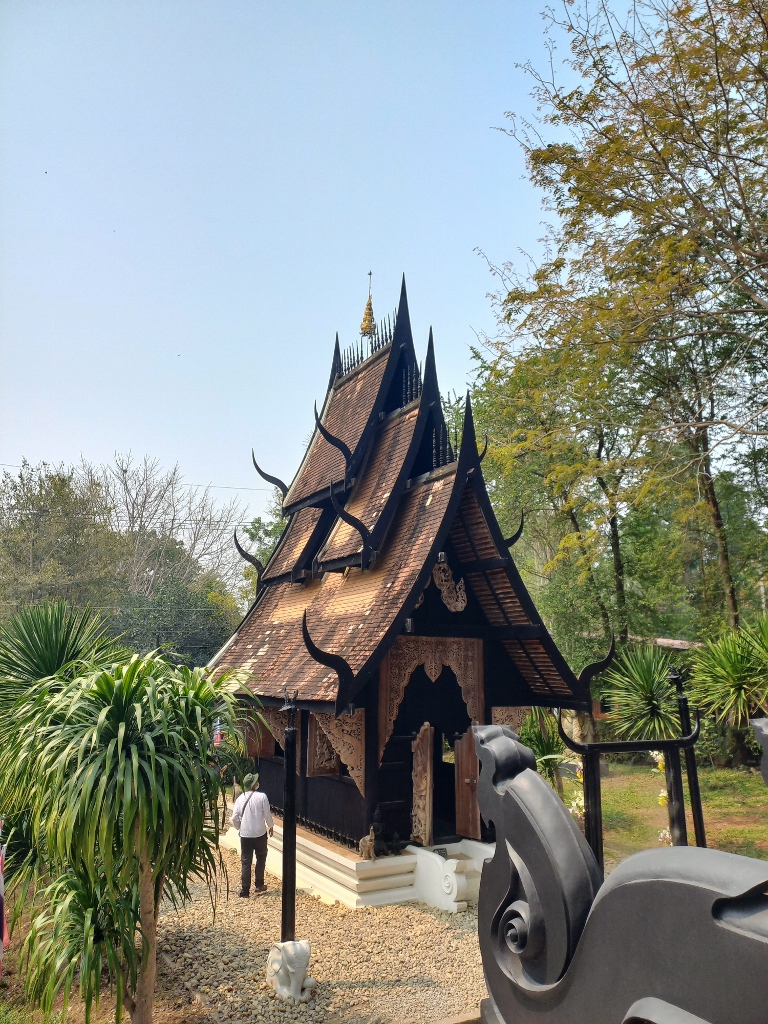 The Baandam Museum, the Sanctuary
The Baandam Museum, the Sanctuary
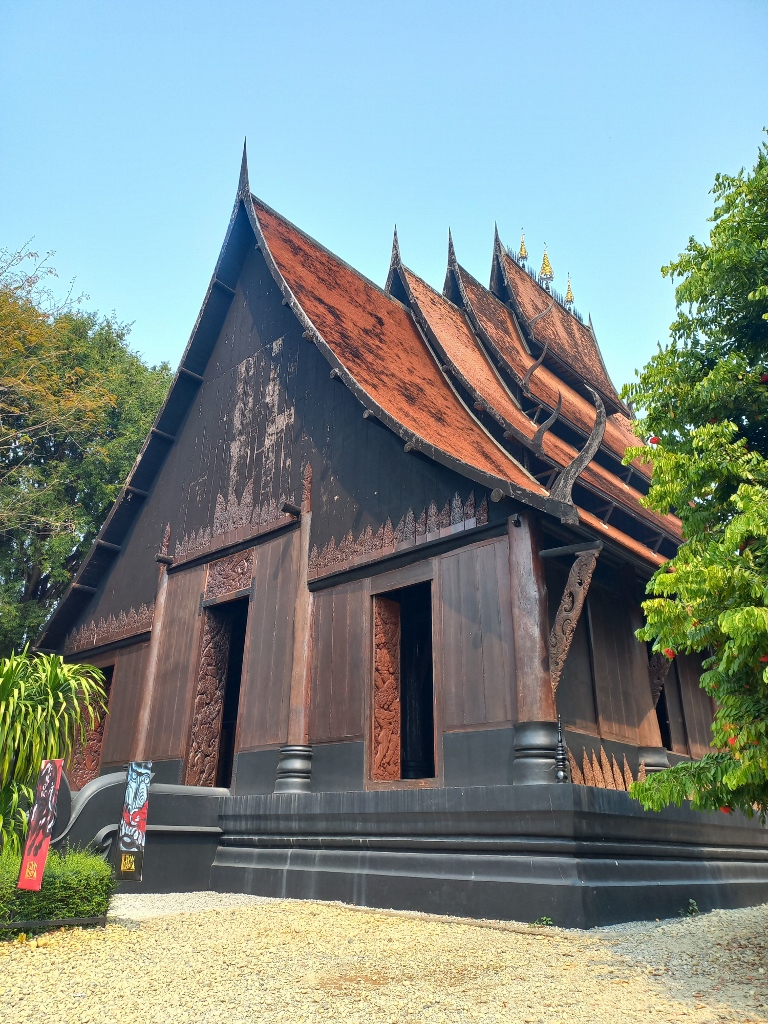 The Baandam Museum, the Main Sanctuary Hall
The Baandam Museum, the Main Sanctuary Hall
The structures themselves already appear very interesting and impressive, but when you step inside and start examining the details, the impressions are fantastic!
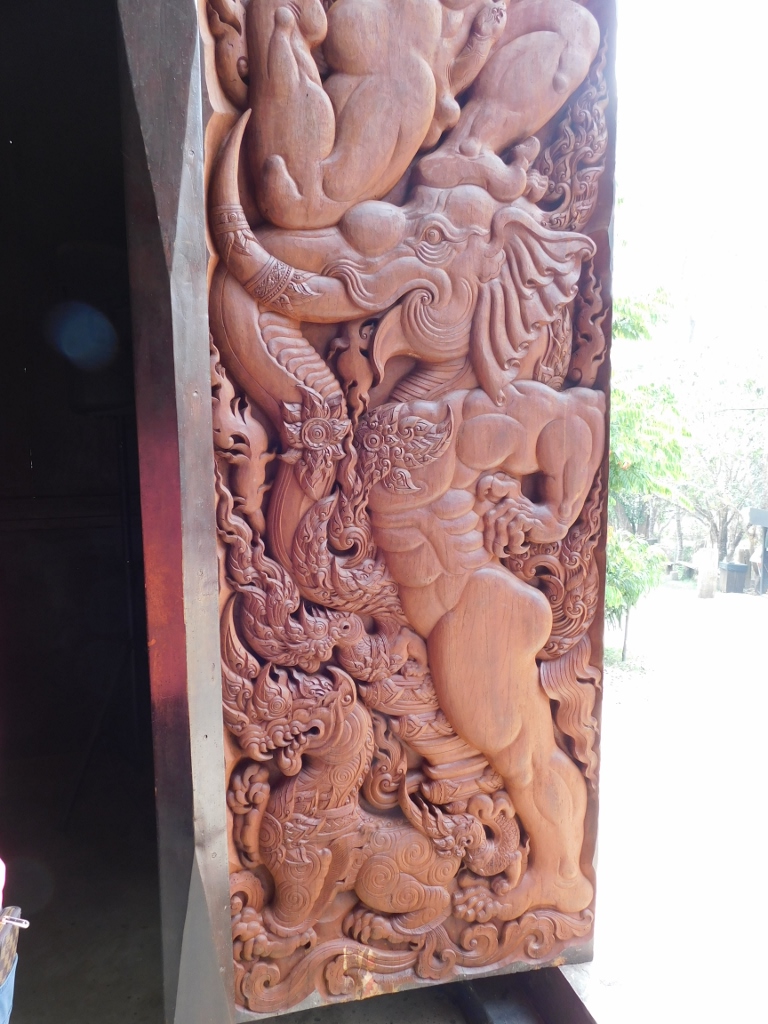 The Baandam Museum, the Main Sanctuary Hall, a detail
The Baandam Museum, the Main Sanctuary Hall, a detail
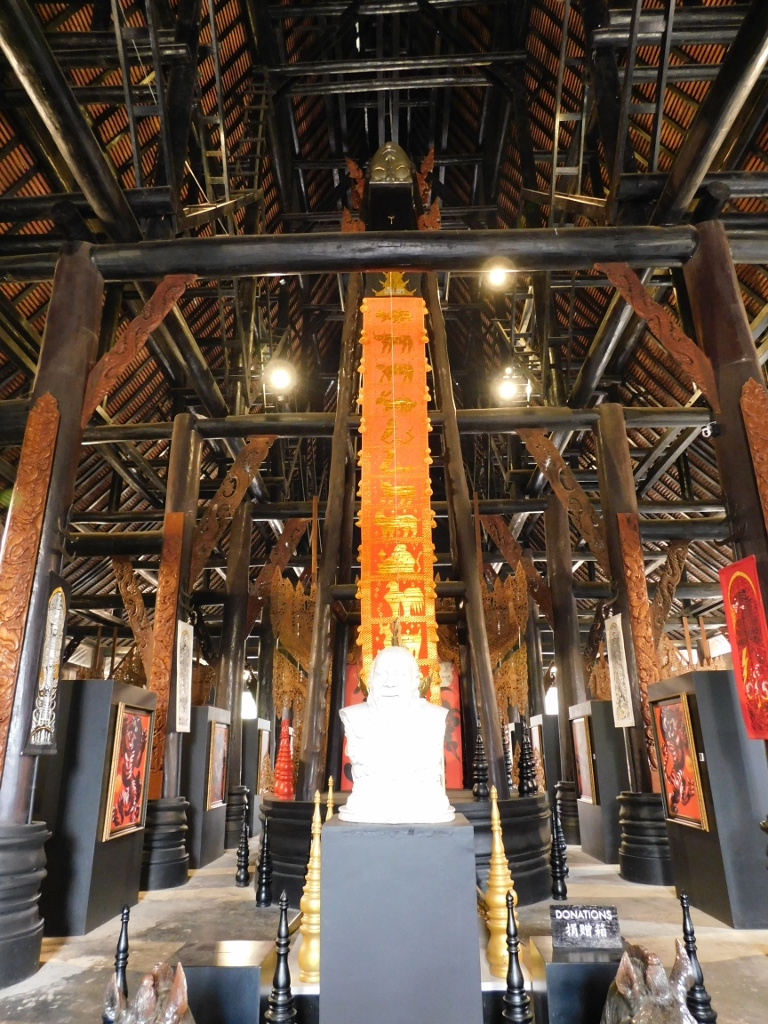 The Baandam Museum, the Main Sanctuary Hall, a detail
The Baandam Museum, the Main Sanctuary Hall, a detail
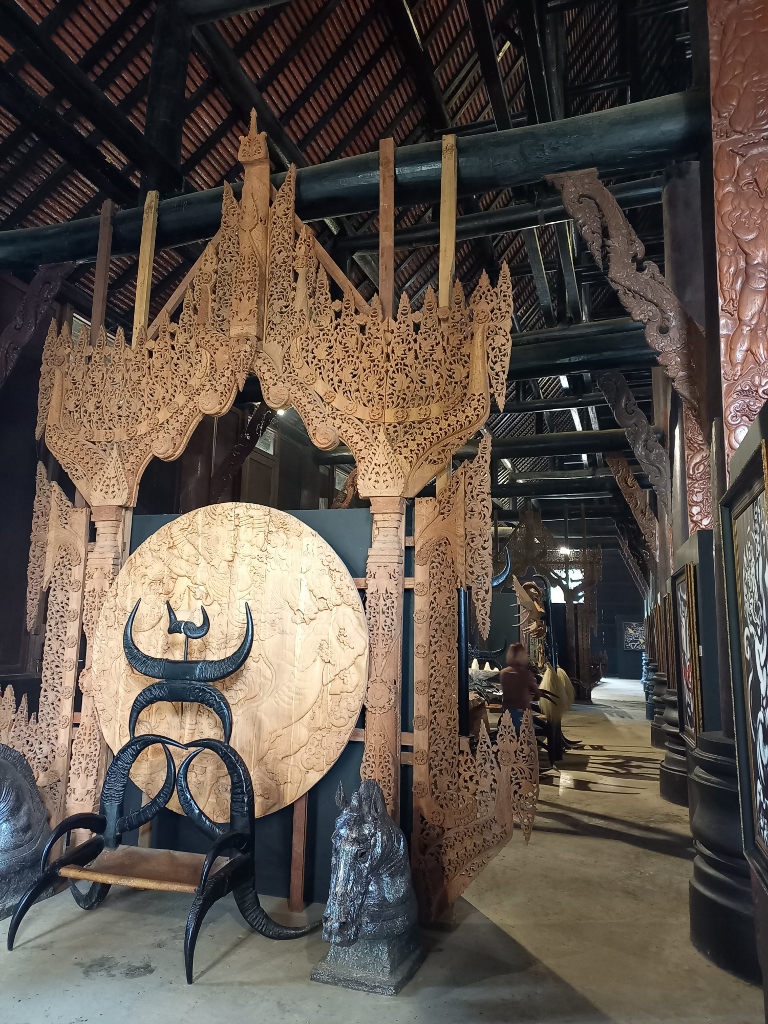 The Baandam Museum, the Main Sanctuary Hall, a detail
The Baandam Museum, the Main Sanctuary Hall, a detail
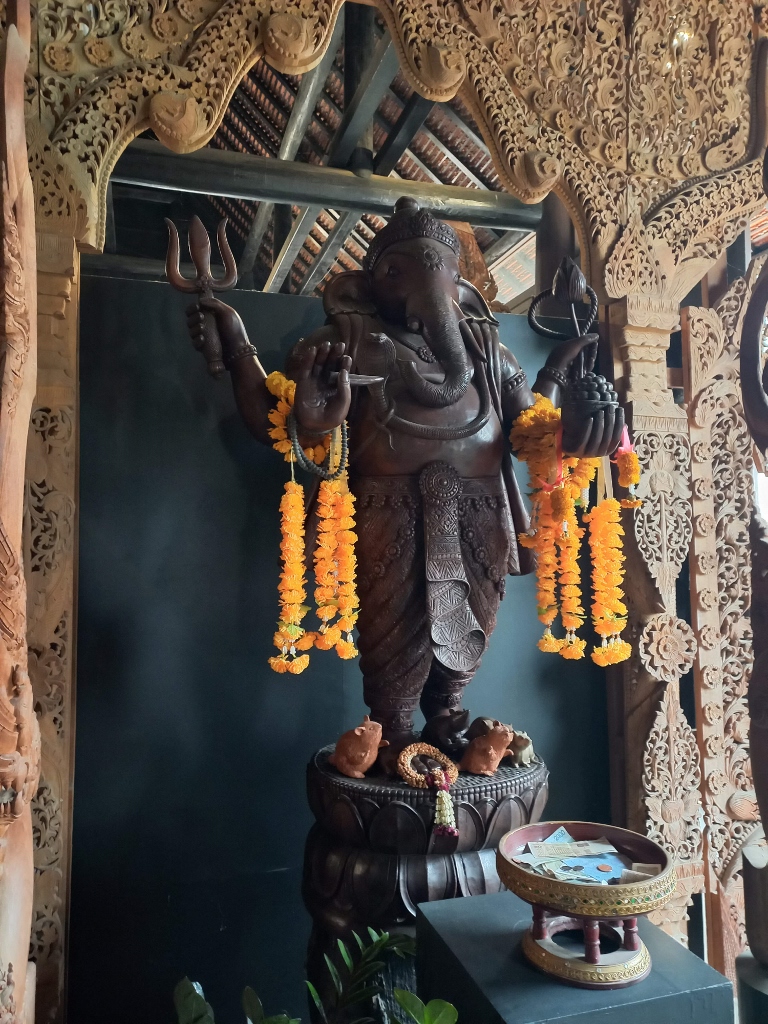 The Baandam Museum, the Main Sanctuary Hall, a detail
The Baandam Museum, the Main Sanctuary Hall, a detail
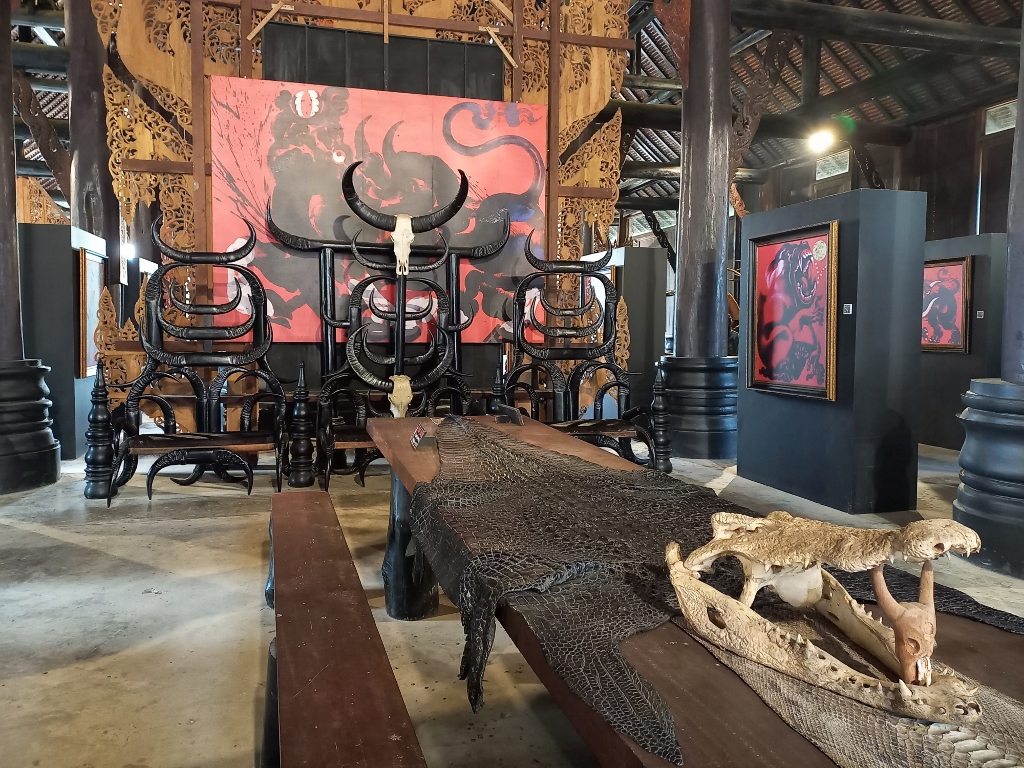 The Baandam Museum, the Main Sanctuary Hall, a detail
The Baandam Museum, the Main Sanctuary Hall, a detail
I then exited at the rear part of the Main Sanctuary Hall, but there were wonderful details and exhibits everywhere.
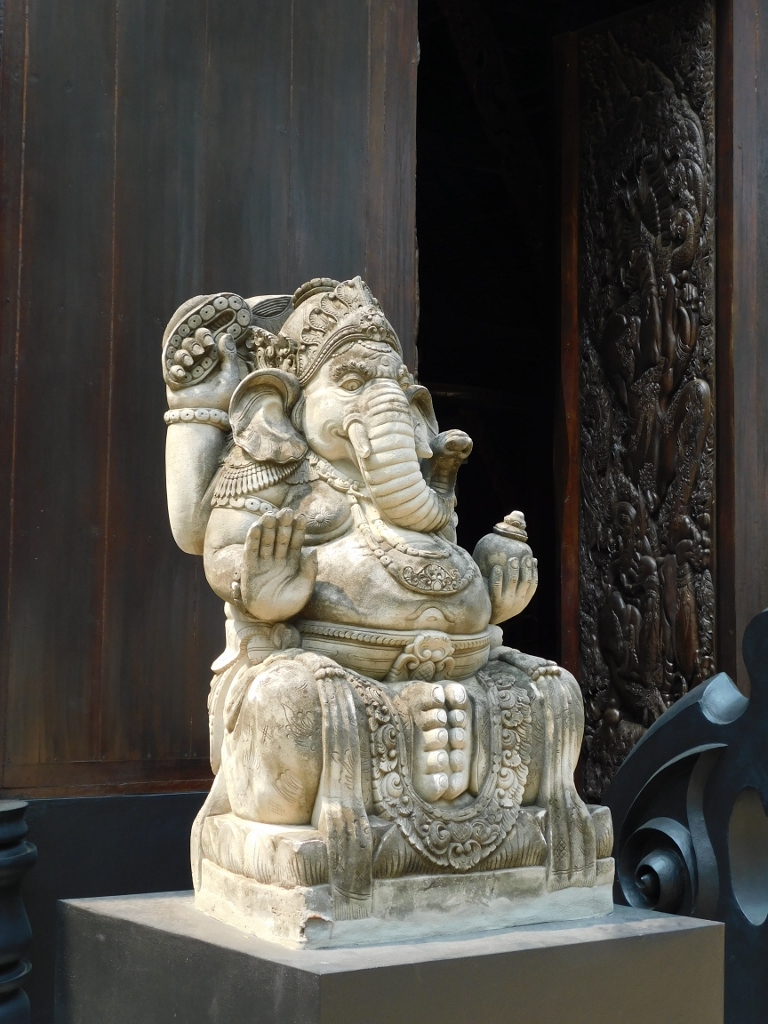 The Baandam Museum, the Main Sanctuary Hall, a detail
The Baandam Museum, the Main Sanctuary Hall, a detail
Right there, you come across the Sanctuary of Rama. I don’t know why certain structures were given specific names, but besides being the artist’s wish, that detail wasn’t crucial to me either, except to know exactly what is depicted in the photograph.
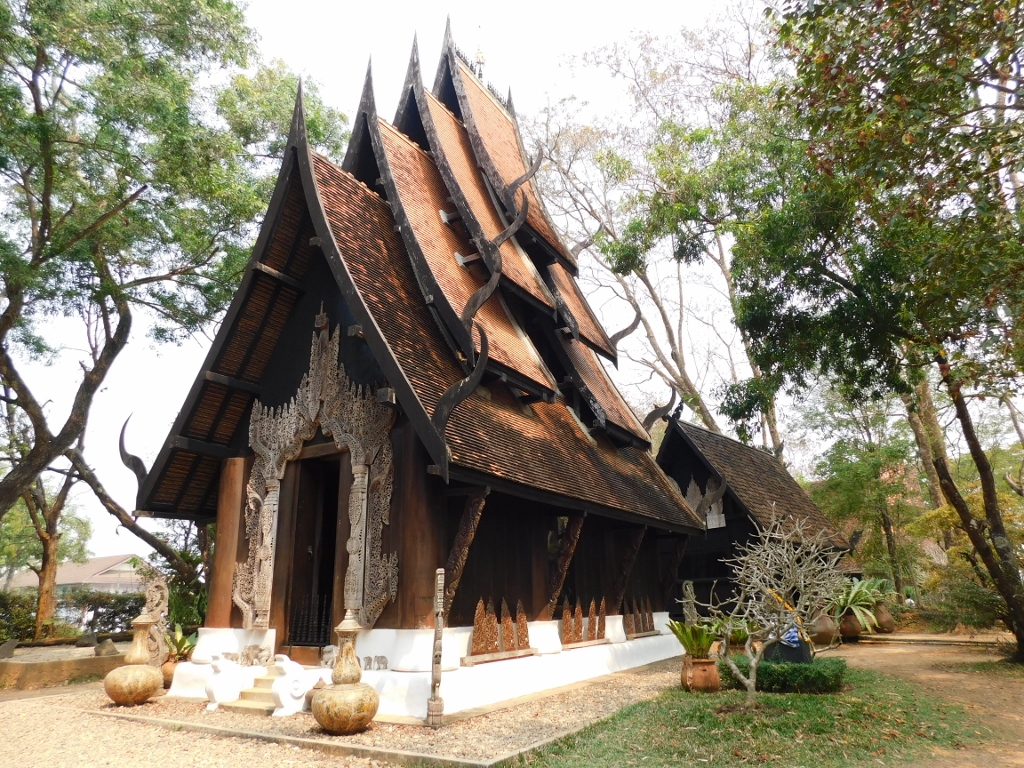 The Baandam Museum, the Sanctuary of Rama
The Baandam Museum, the Sanctuary of Rama
Here, I moved a bit aside to get an even better view of the impressive roof of the Sanctuary of Rama and then I returned to the rear facade of the same structure. The level of detail in the decoration was spectacular!
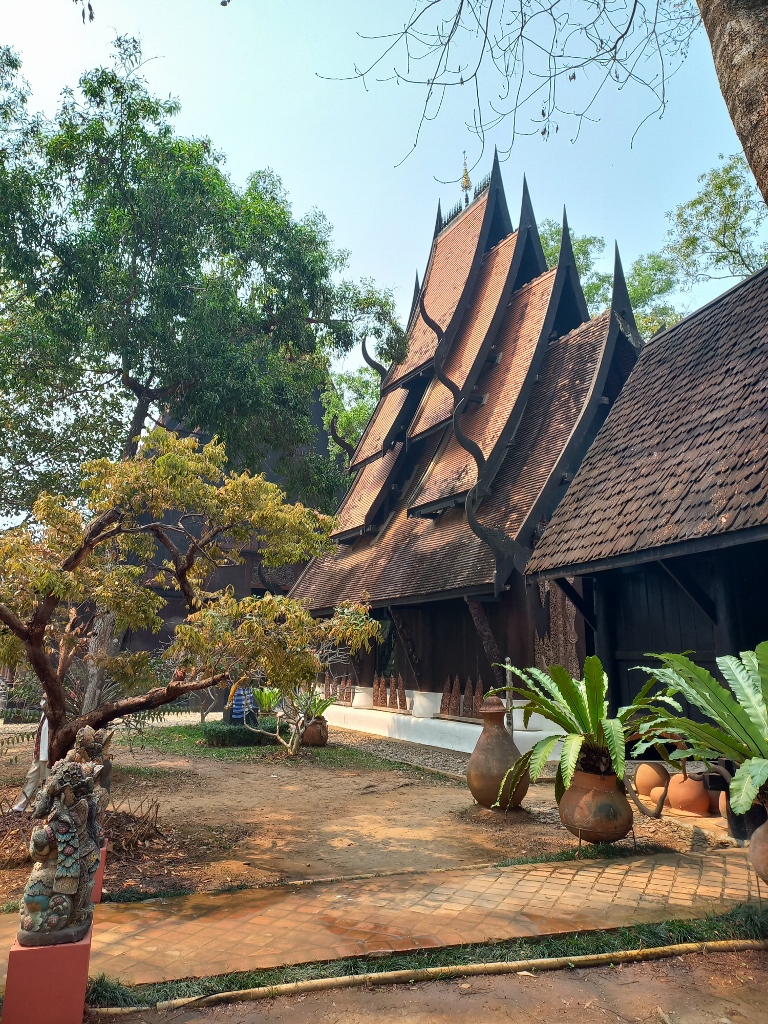 The Baandam Museum, the Sanctuary of Rama
The Baandam Museum, the Sanctuary of Rama
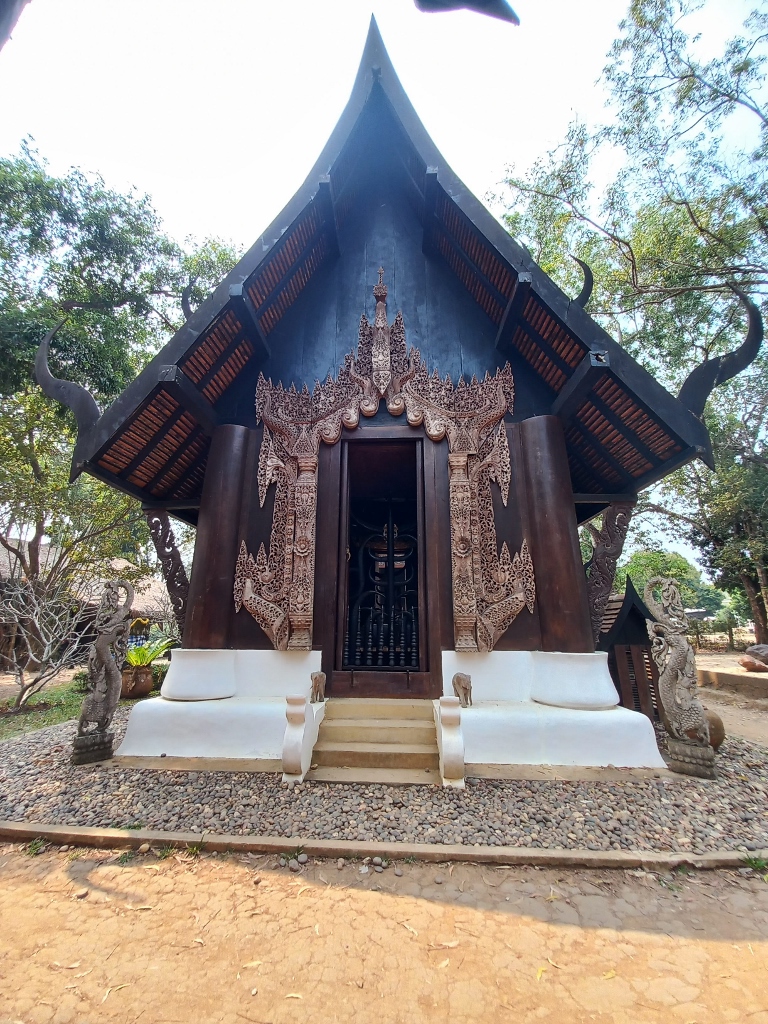 The Baandam Museum, the Sanctuary of Rama
The Baandam Museum, the Sanctuary of Rama
Right across from the rear side of the Sanctuary of Rama, two smaller structures are visible, with another, a larger one a bit further away. The next photo was taken as a panoramic shot, so the proportions may not necessarily be accurate.
 The Baandam Museum
The Baandam Museum
On the left-hand side there is the Dipper Toilet, which is here primarily as an artistic piece, while on the right-hand side there is the Barn House. A bit further is the Artist Studio, which is better visible in the next photograph.
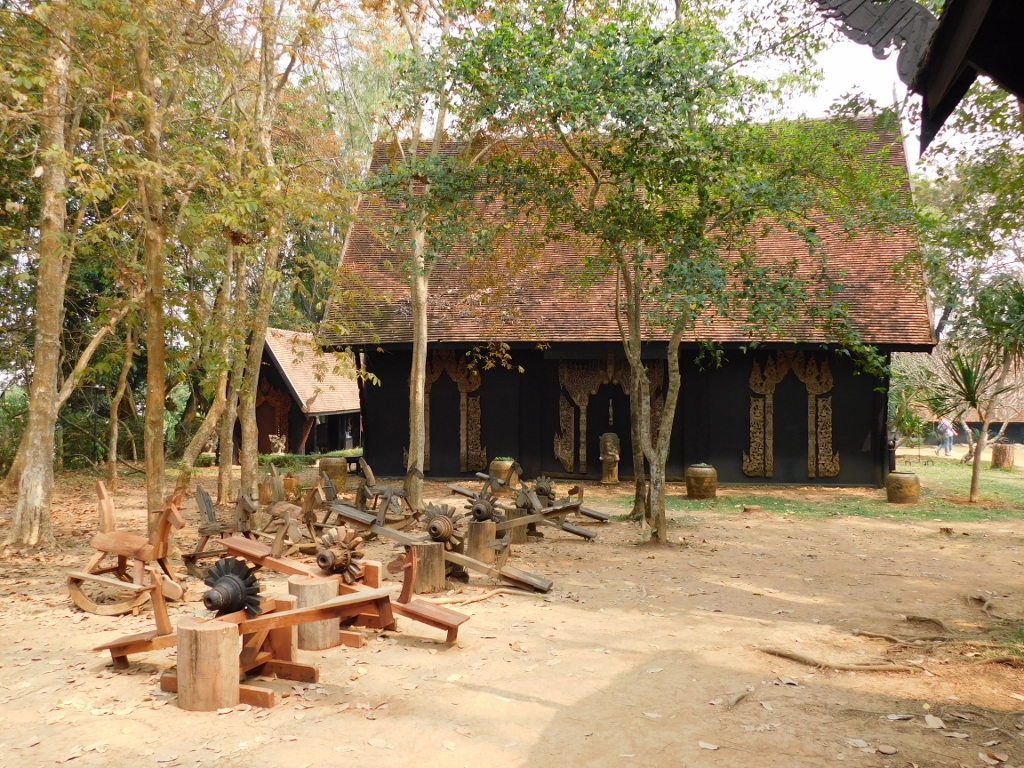 The Baandam Museum, Artist Studio
The Baandam Museum, Artist Studio
Right next to the Artist Studio is the Twelve Gable Triples Black House. Just to mention, I did not come up with these names; they can be found in the official brochure that is provided at the entrance to the museum.
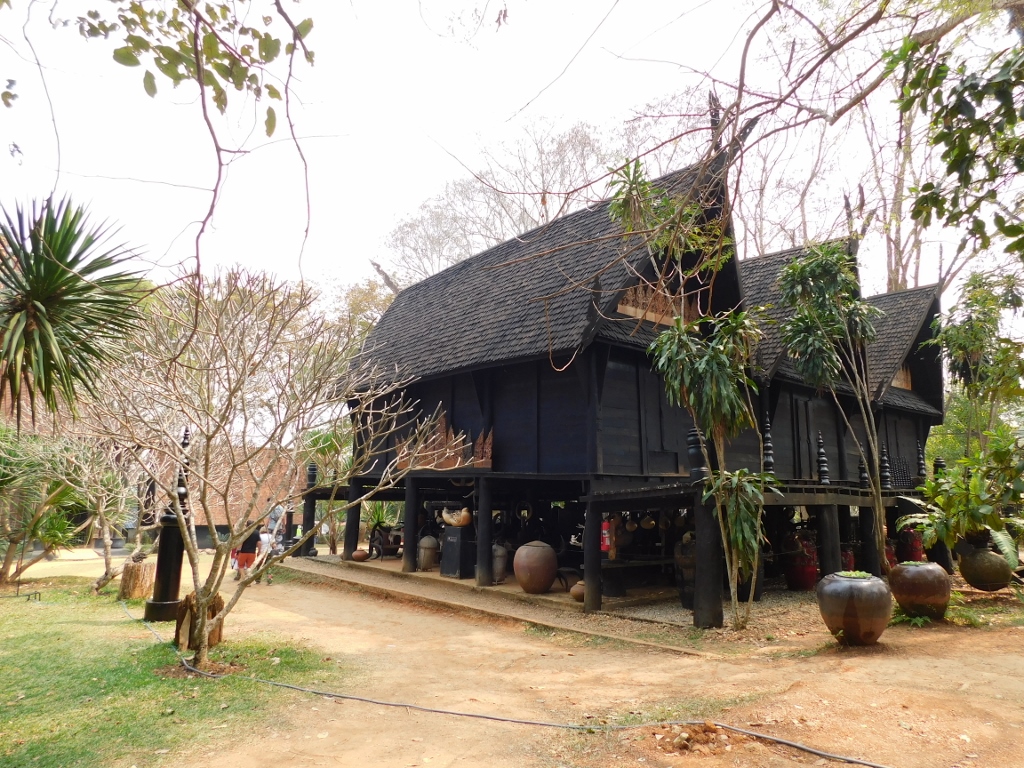 The Baandam Museum, Twelve Gable Triples Black House
The Baandam Museum, Twelve Gable Triples Black House
It is clearly visible that this structure is composed of three parts, but what is additionally interesting is that it resembles a massive stilt house, with space underneath filled with various details, including a long table and very interesting chairs. Certainly, it must be quite an experience when a larger group gathers there.
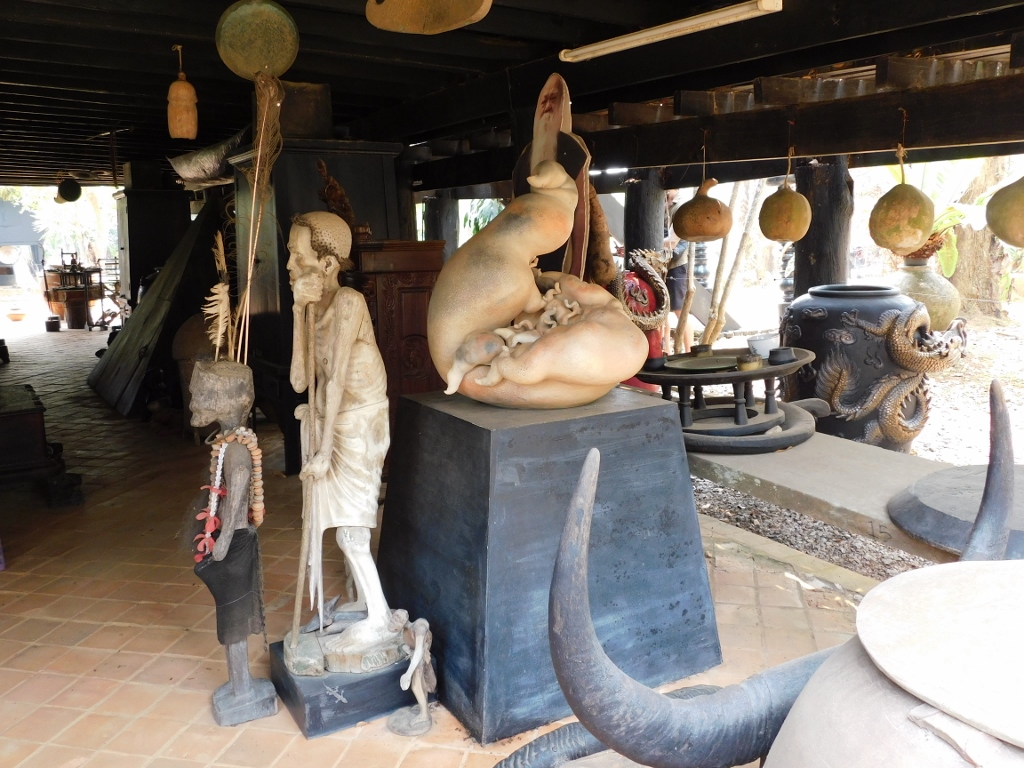 The Baandam Museum, Twelve Gable Triples Black House
The Baandam Museum, Twelve Gable Triples Black House
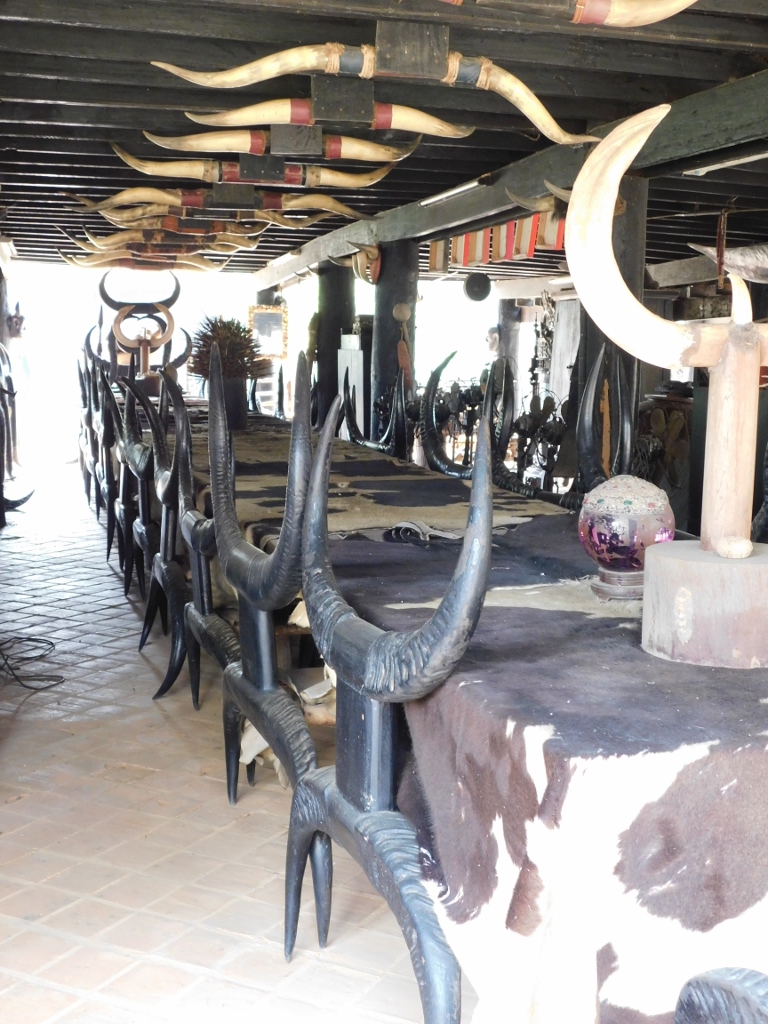 The Baandam Museum, Twelve Gable Triples Black House
The Baandam Museum, Twelve Gable Triples Black House
I took a photo of this house again a bit later from a different angle, but here is the photo right away.
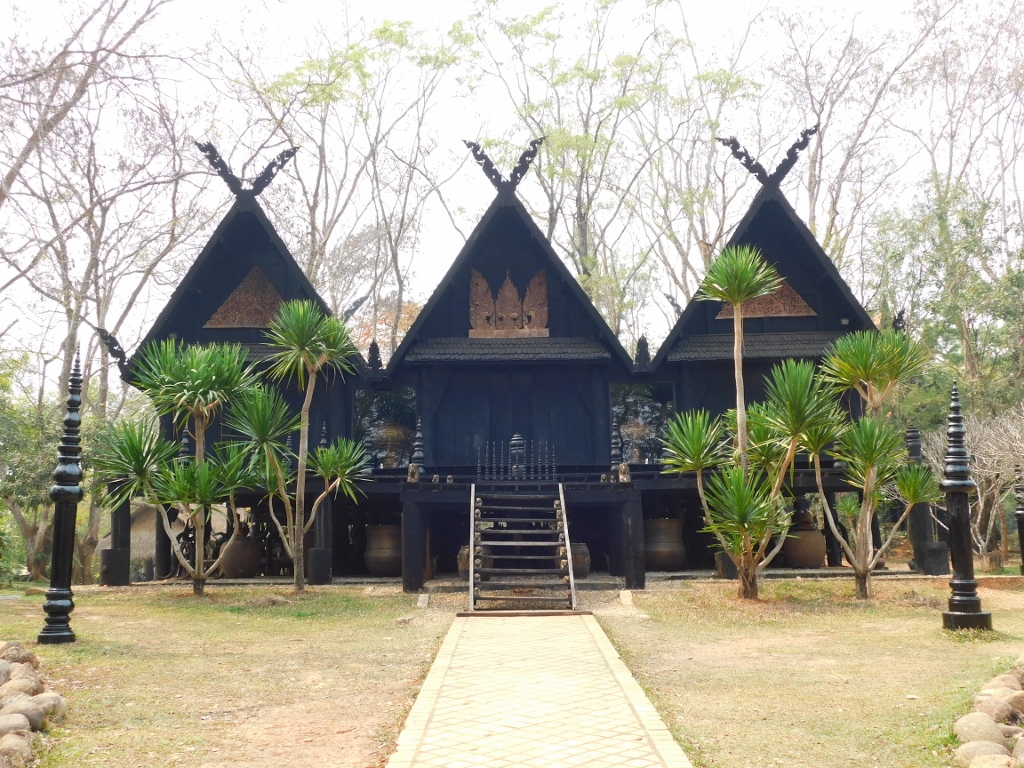 The Baandam Museum, Twelve Gable Triples Black House
The Baandam Museum, Twelve Gable Triples Black House
In the north-eastern corner of the estate, there is a pair of buildings, visible in the following photograph. On the left is the East Pavilion, on the right is the Reptile House, while in the middle behind them is a toilet intended for visitors. Each one of them is interesting in its own way.
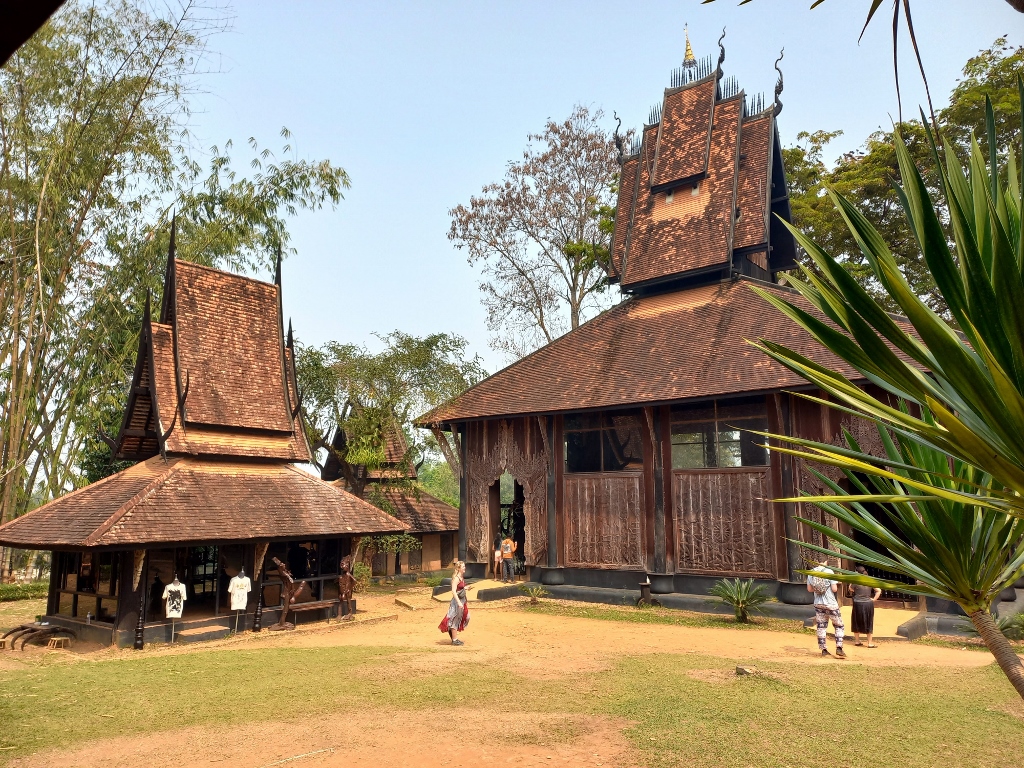 The Baandam Museum
The Baandam Museum
In front of the East Pavilion, you can see the type of figures that the artist often created and that are placed in several locations within the museum.
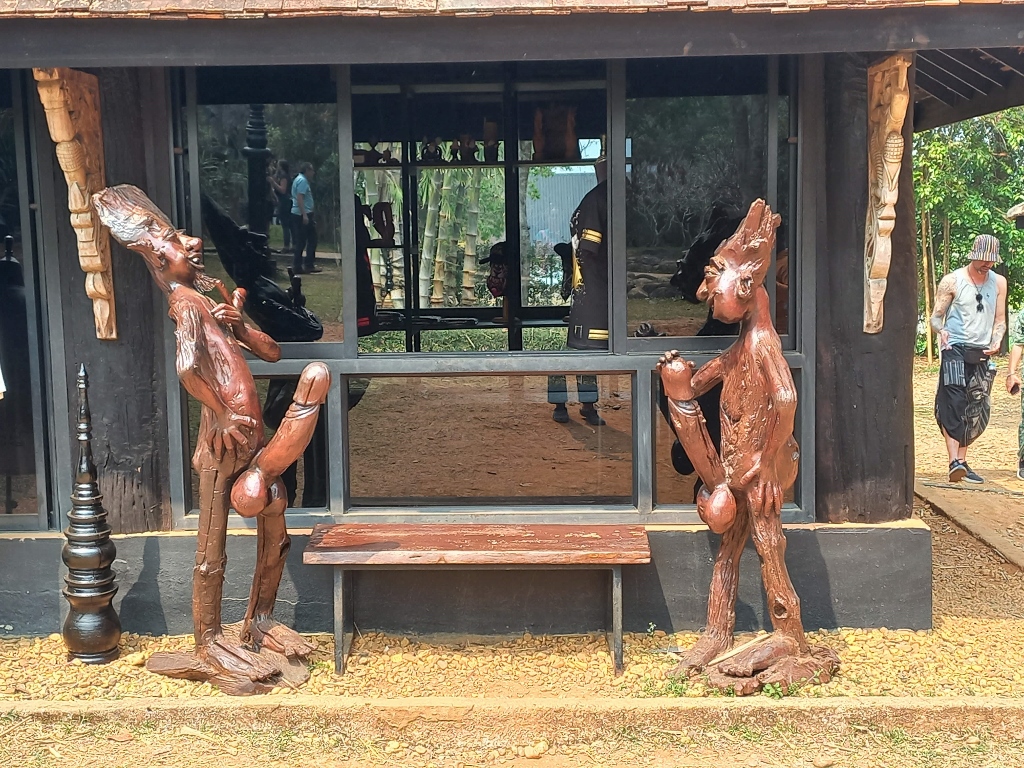 The Baandam Museum, East Pavilion
The Baandam Museum, East Pavilion
Even the toilet for visitors has undeniable artistic details, starting from its shape to intricately carved doors.
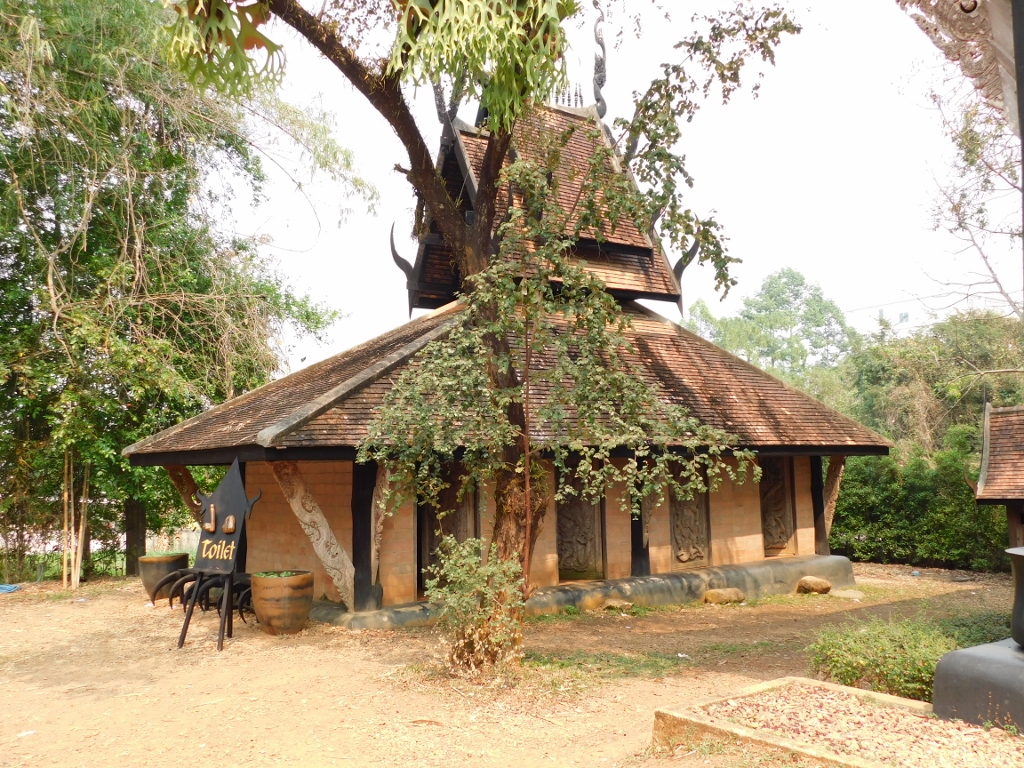 The Baandam Museum, visitor toilet
The Baandam Museum, visitor toilet
In this part of the museum, the Reptile House is particularly impressive. In the next photo, on the right-hand side next to it, you can also see a part of one of the Guesthouses, which is the name given to some of the structures.
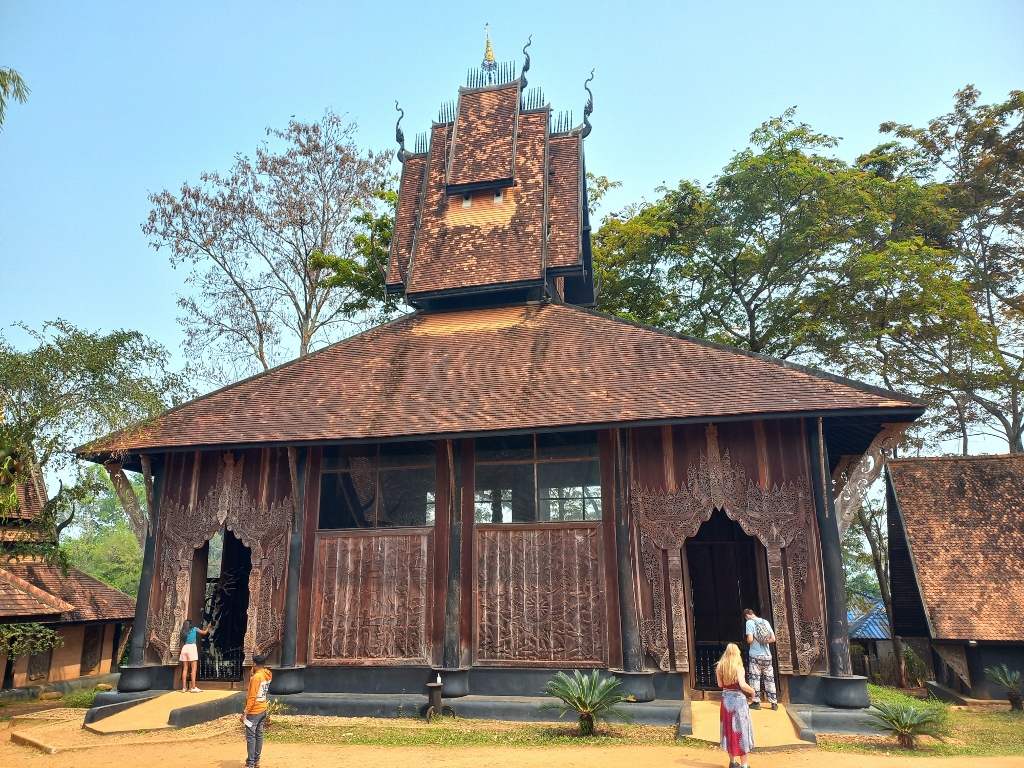 The Baandam Museum, Reptile House
The Baandam Museum, Reptile House
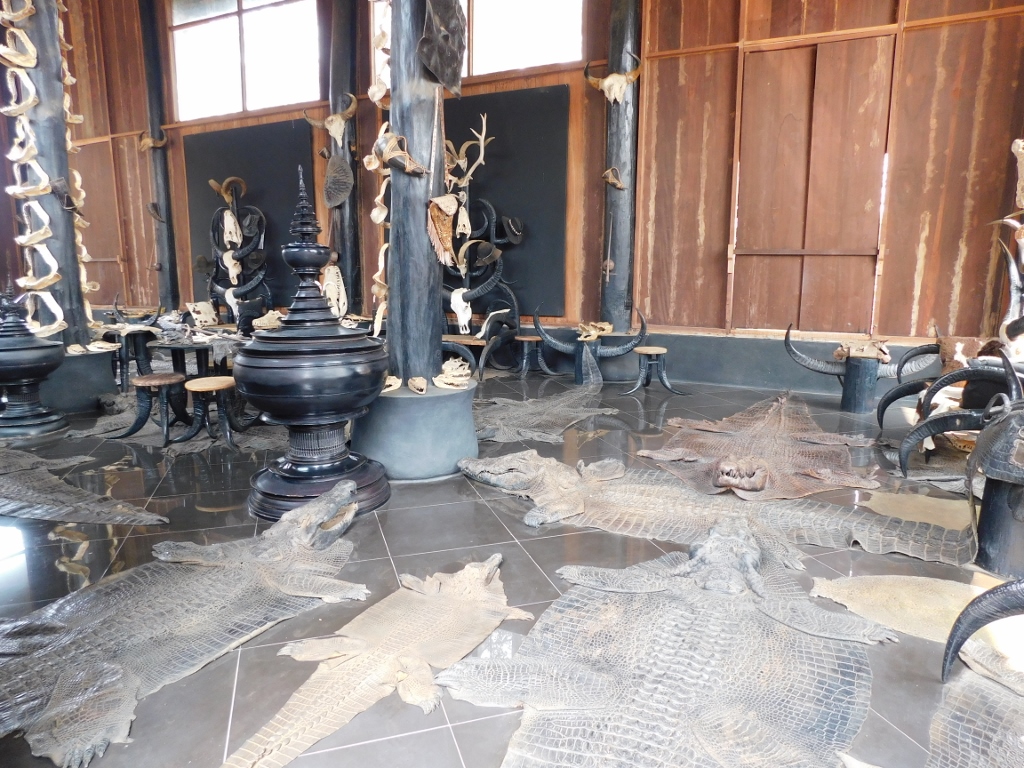 The Baandam Museum, Reptile House
The Baandam Museum, Reptile House
One other Guesthouse can be seen across the lawn, more towards the central part of the estate. Since we, as a group, had limited time for the visit, I couldn’t explore each of these structures, but I made an effort to capture them on camera, either in their entirety or partially.
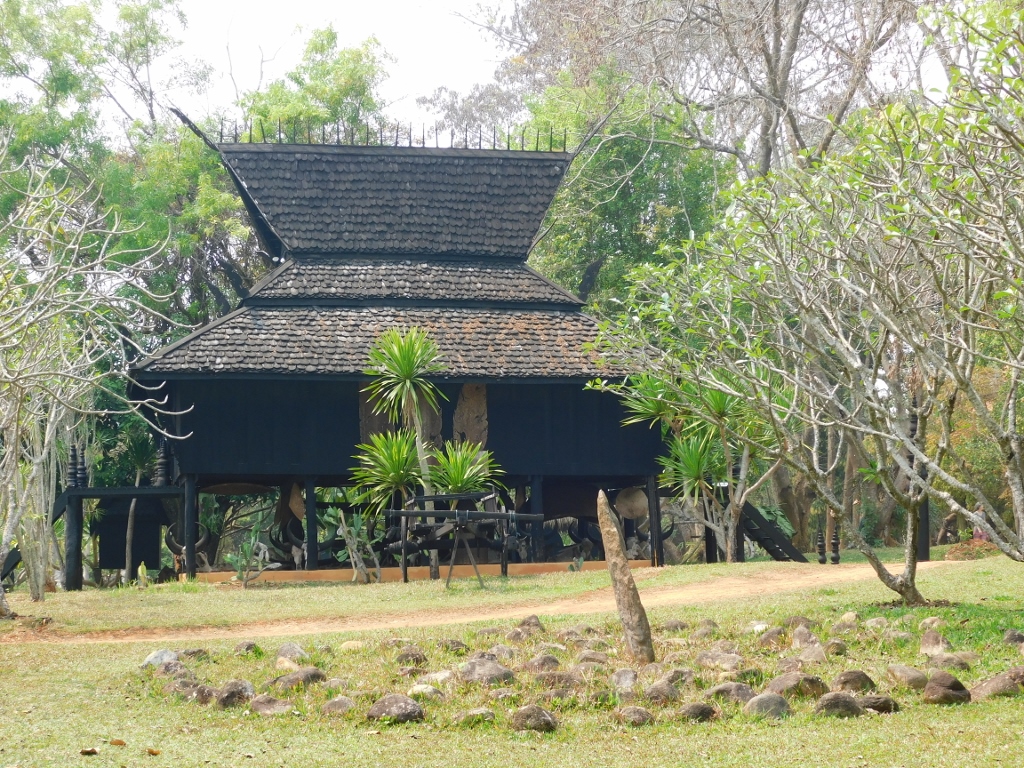 The Baandam Museum, Guesthouse
The Baandam Museum, Guesthouse
On the other hand, some structures are not meant for exploration, but rather for observation, like true exhibits in a museum. For instance, the Tripitaka Hall, whose name originates from Sanskrit and means “Three Baskets,” referring to ancient collections of Buddhist sacred texts. This structure reminded me of an antique library I saw in Chiang Mai and it made perfect sense.
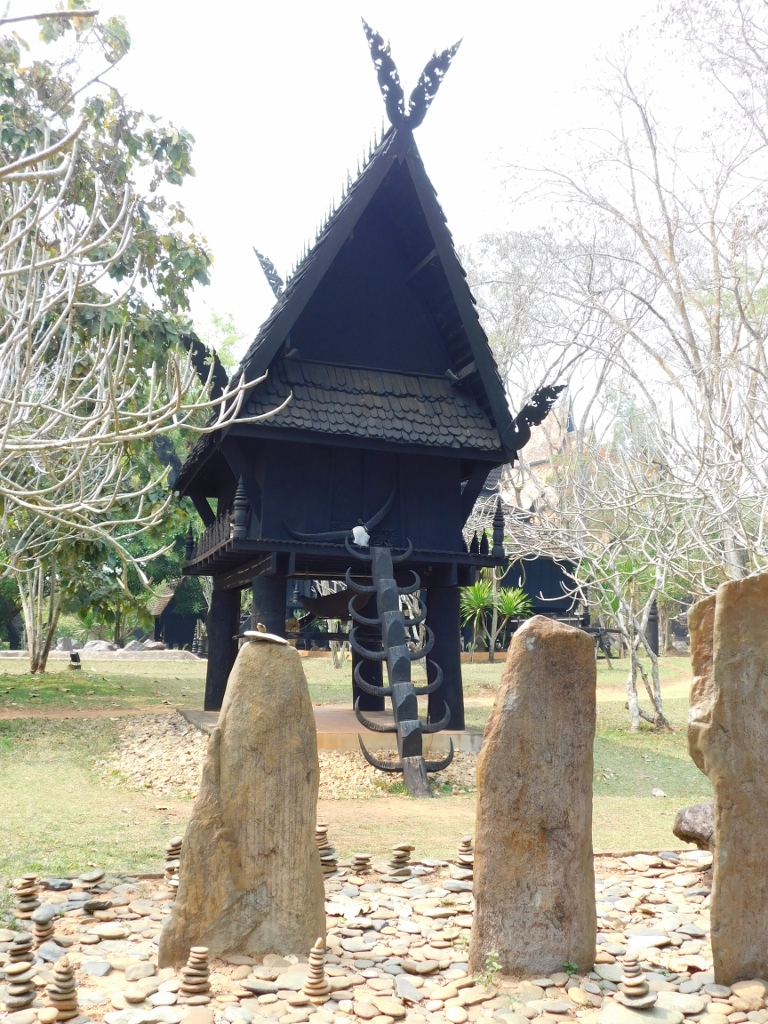 The Baandam Museum, Tripitaka Hall
The Baandam Museum, Tripitaka Hall
By the way, in front of the Tripitaka Hall, there is another open-air exhibit, consisting of stones of various sizes arranged within a low rectangular platform.
Right by the Tripitaka Hall, there is a series of three interconnected structures. The first one I came across was the Shan Pavilion, followed by the slightly larger Pearl House.
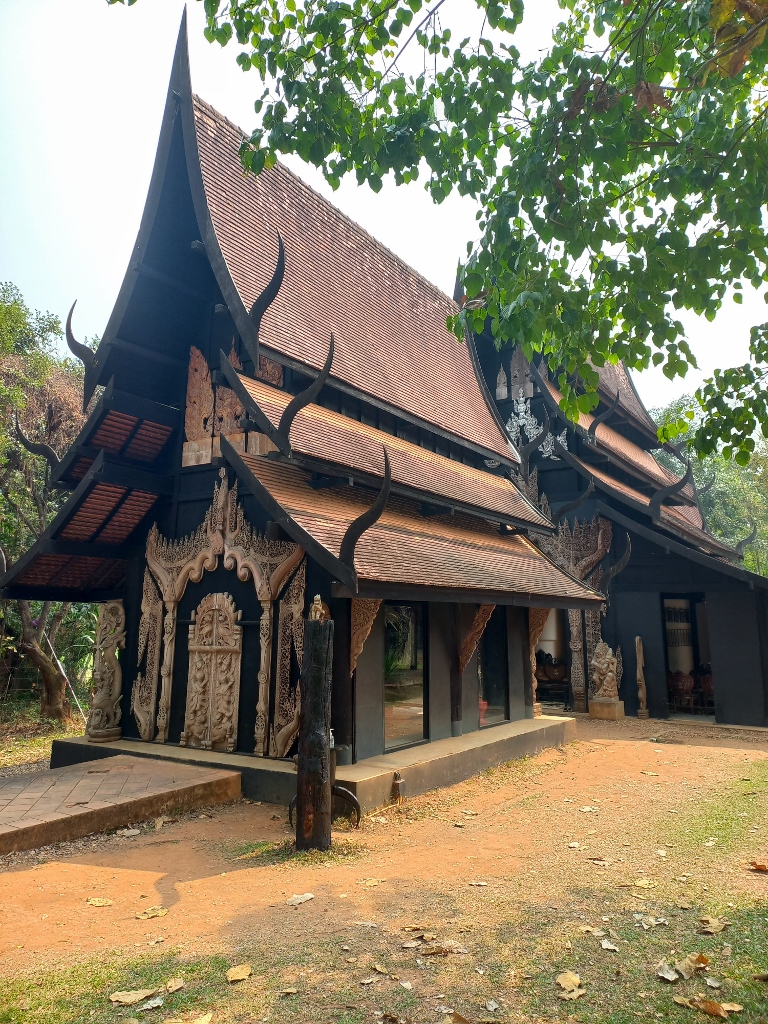 The Baandam Museum, Shan Pavilion
The Baandam Museum, Shan Pavilion
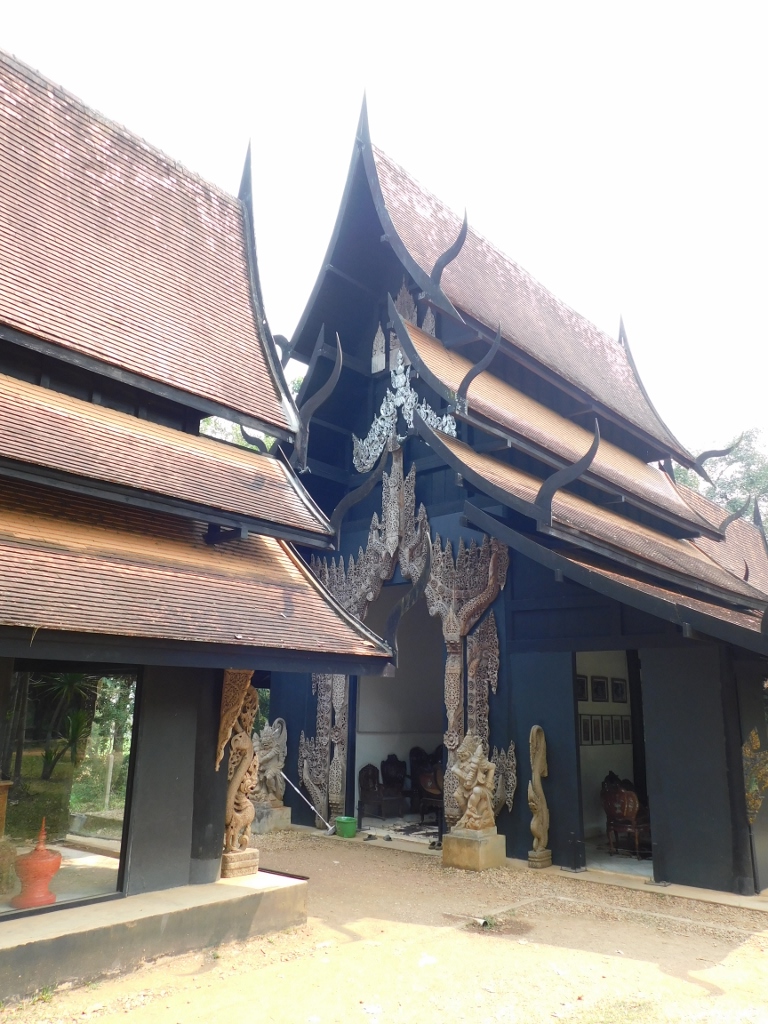 The Baandam Museum, Pearl House
The Baandam Museum, Pearl House
Some work was underway here, but I still managed to capture a few details in photographs.
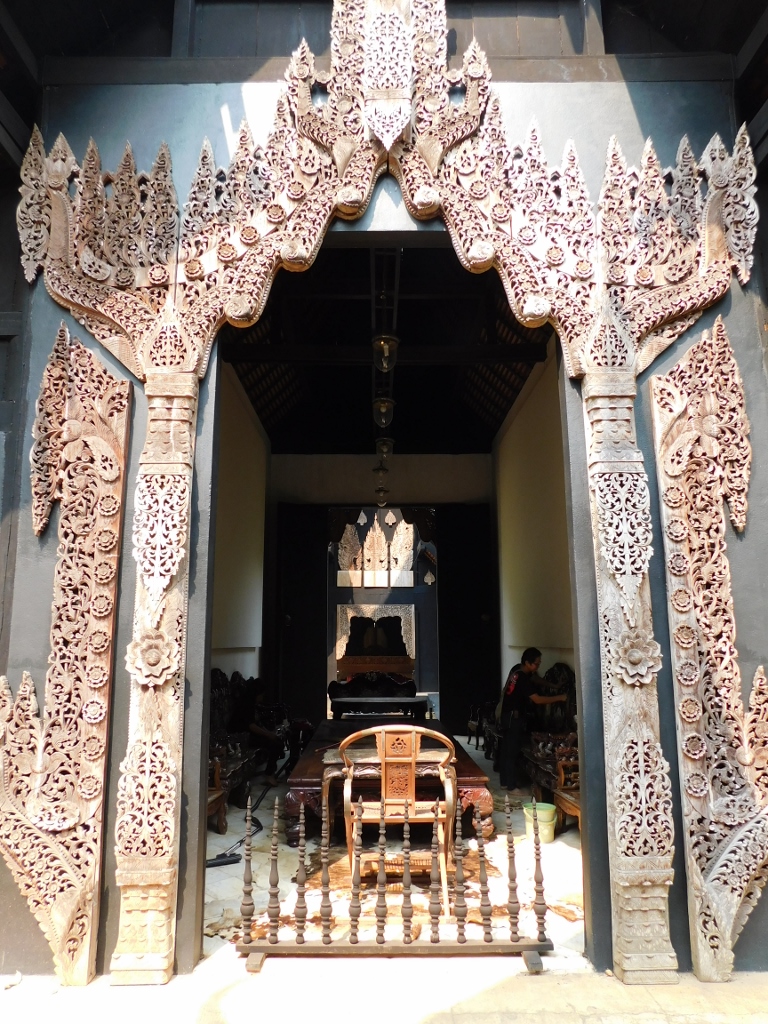 The Baandam Museum, Pearl House
The Baandam Museum, Pearl House
The third structure in the series is the Reclining Buddha Pavilion, visible in the next photo on the right-hand side, while a smaller structure, the Four Buddha Pavilion, can be seen in the centre of the image.
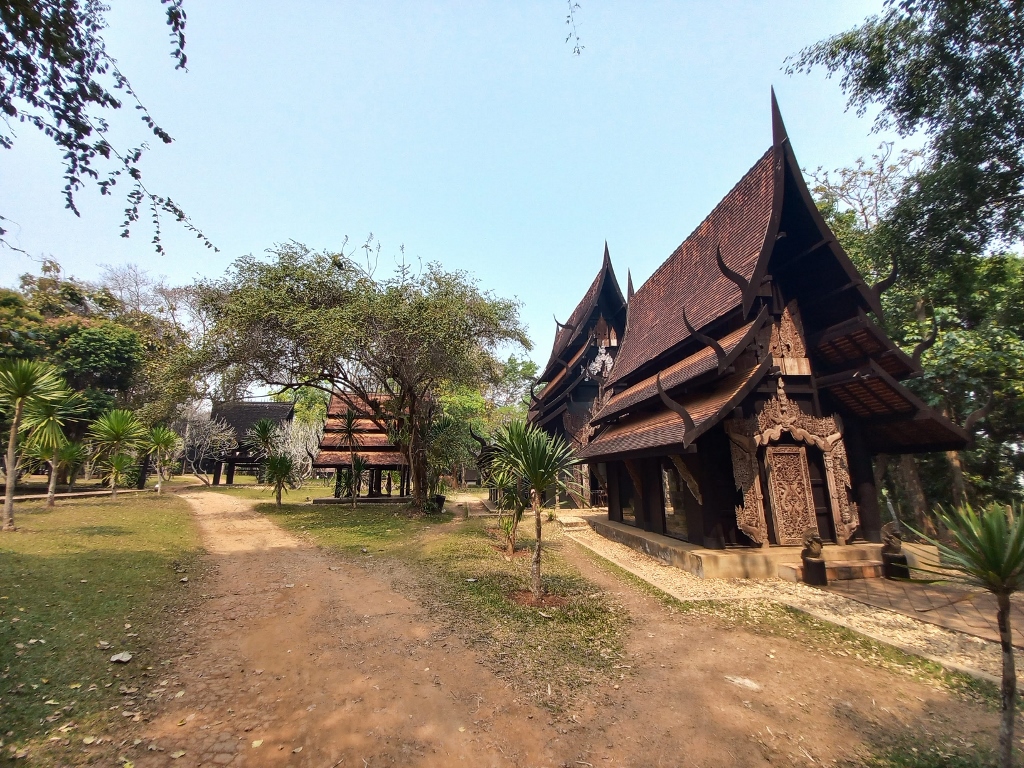 The Baandam Museum
The Baandam Museum
A little farther I reached the Knife Pavilion.
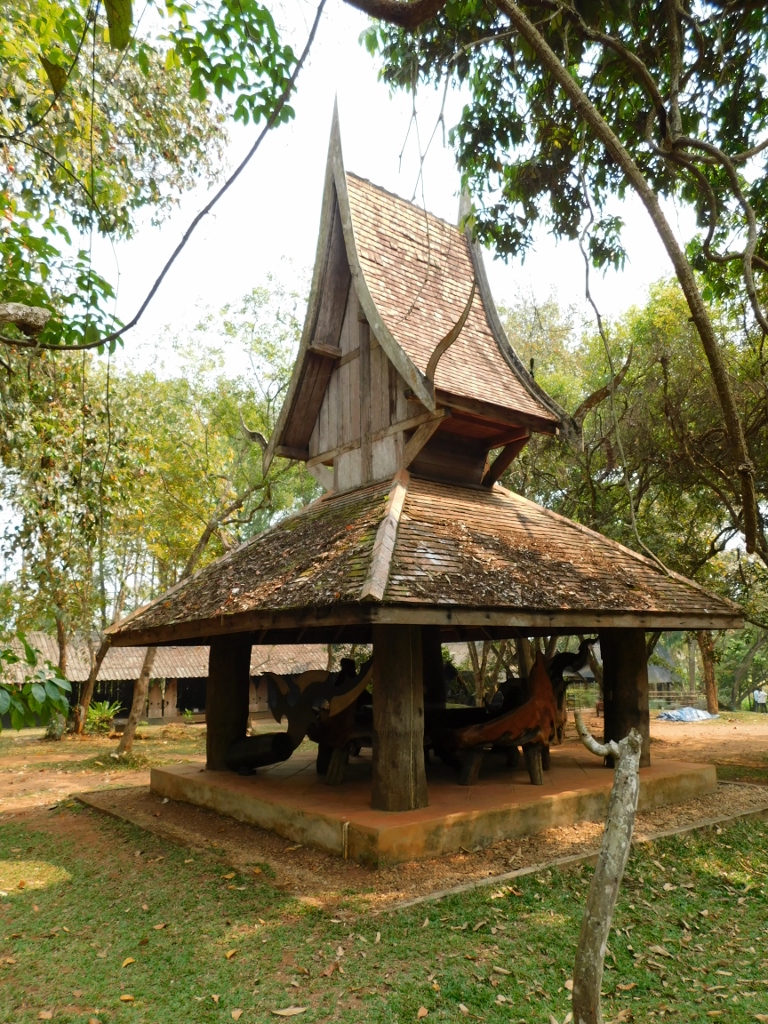 The Baandam Museum, Knife Pavilion
The Baandam Museum, Knife Pavilion
In the far southeast corner of the estate or, rather, the open-air museum, there is the Ring House, in front of which there is another art installation resembling a Zen garden. Quite close to these structures, a couple of water buffaloes (Bubalus bubalis) were peacefully grazing.
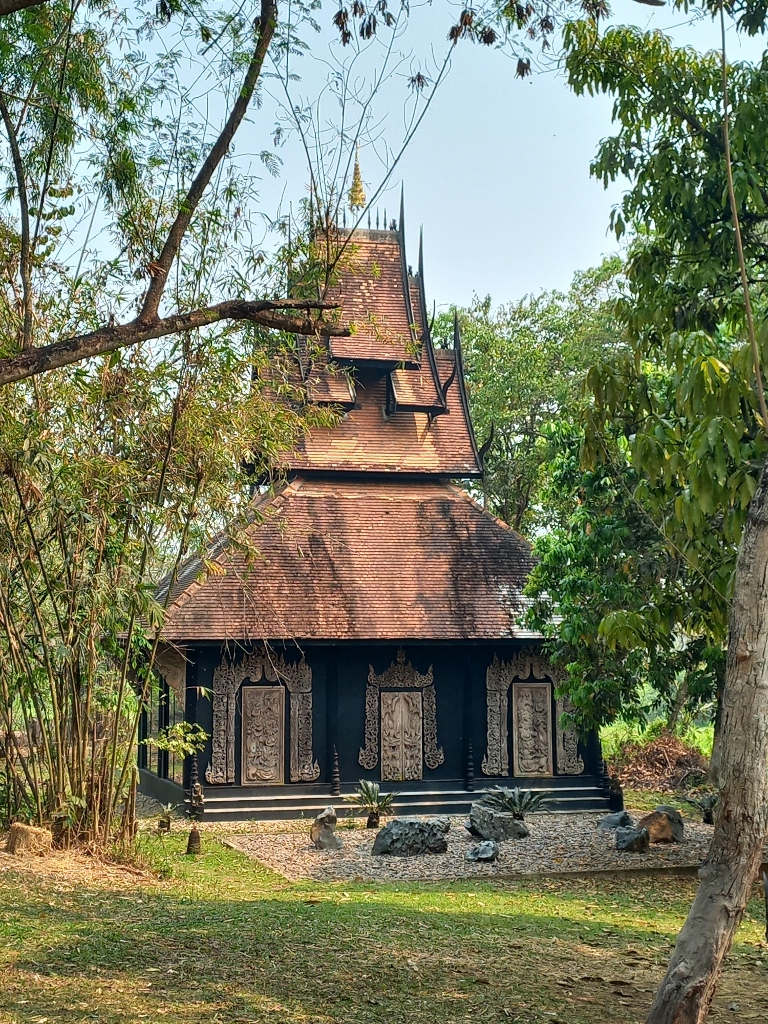 The Baandam Museum, Ring House
The Baandam Museum, Ring House
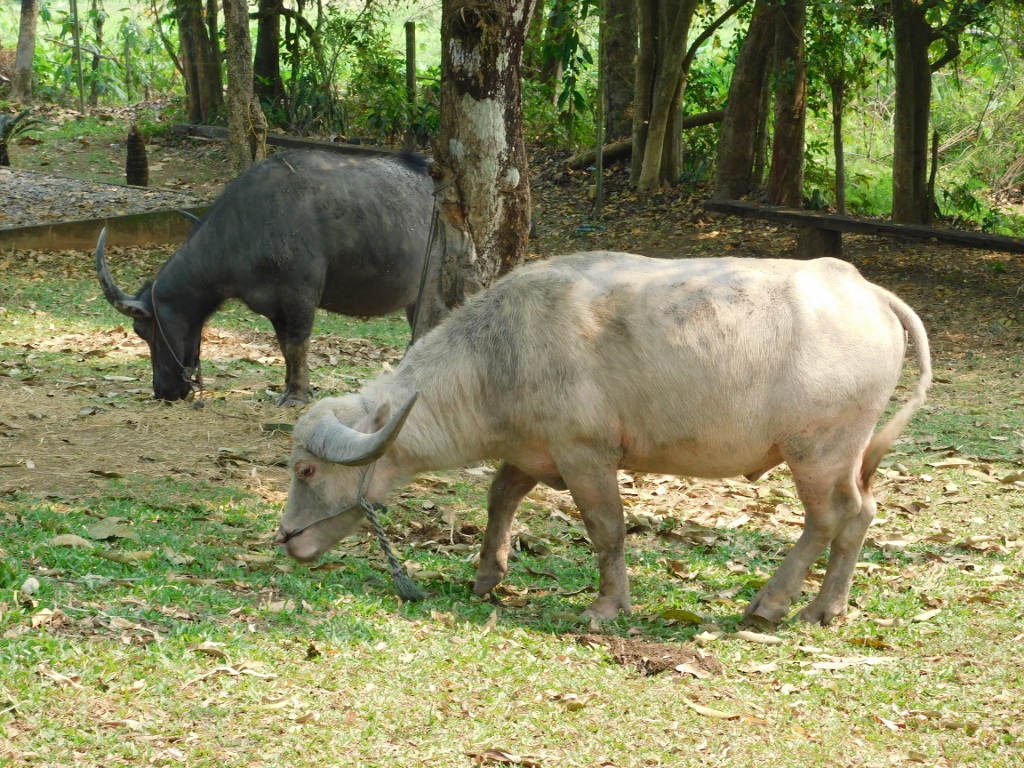 The Baandam Museum, water buffalos
The Baandam Museum, water buffalos
Up until now, the structures at the Baandam Museum were mostly traditional or at least influenced by traditional styles. Then, I came across the Hornbill House, next to which is the Drum Pavilion. I believe Thawan Duchanee had a great deal of fun and playfulness while creating all of this.
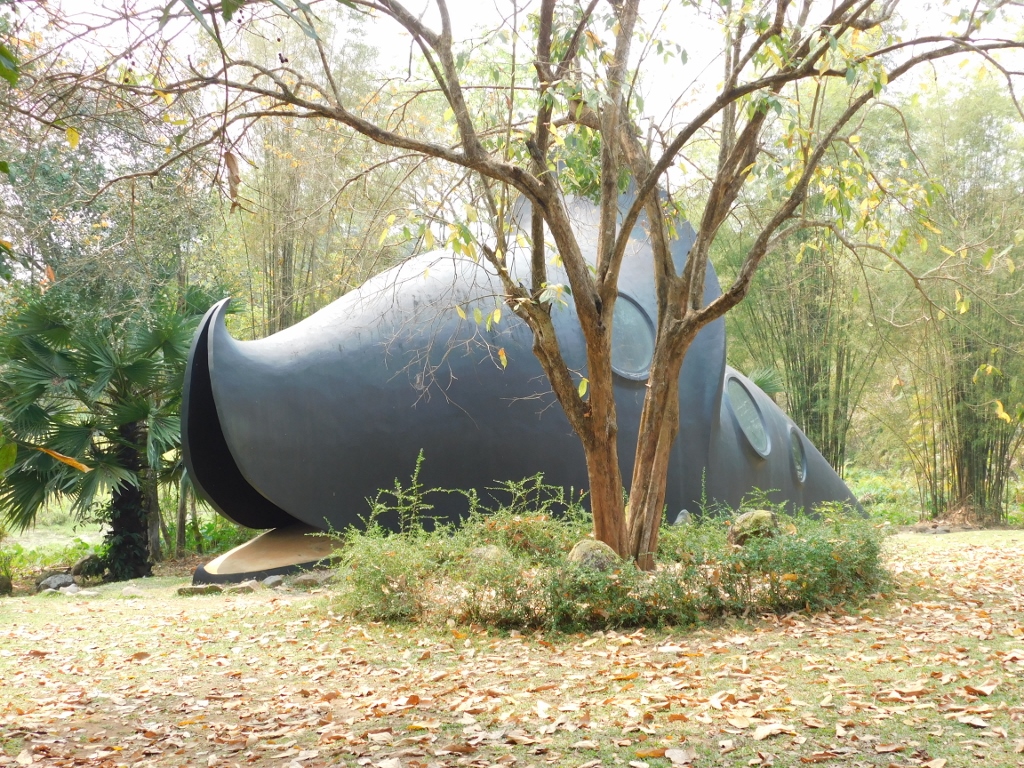 The Baandam Museum, Hornbill House
The Baandam Museum, Hornbill House
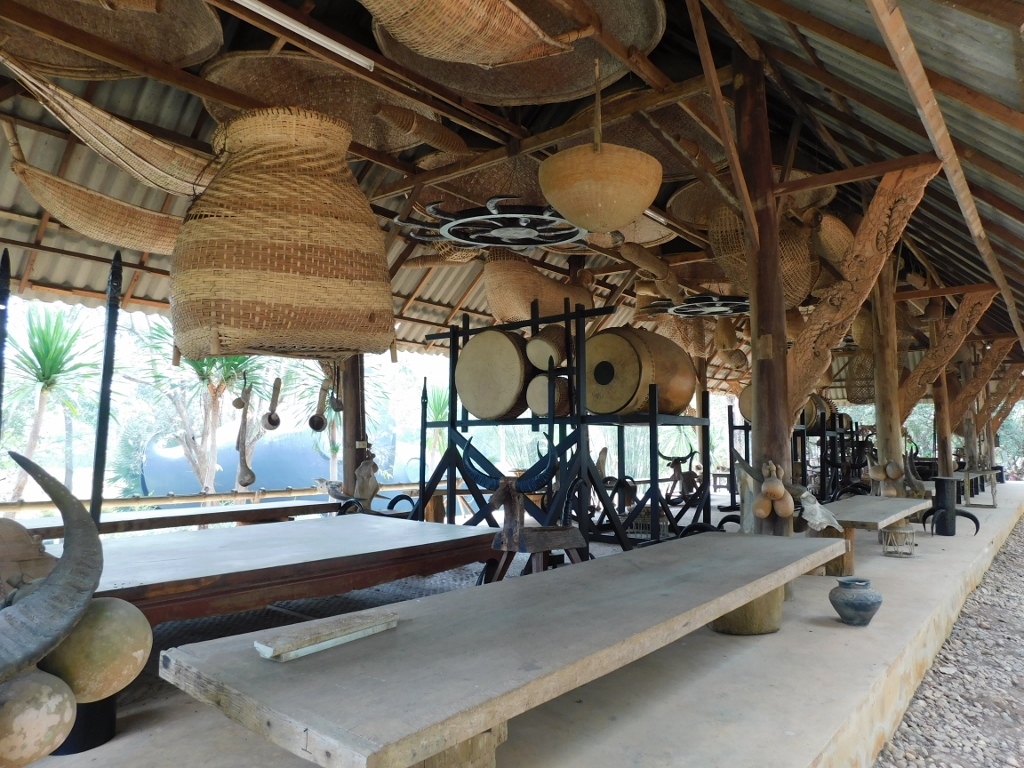 The Baandam Museum, Drum Pavilion
The Baandam Museum, Drum Pavilion
However, despite these various drums, this part of the museum is dominated by abstract forms, such as the three stupas – the Meditation Stupa, Time of Tears Stupa, and Solitude Stupa.
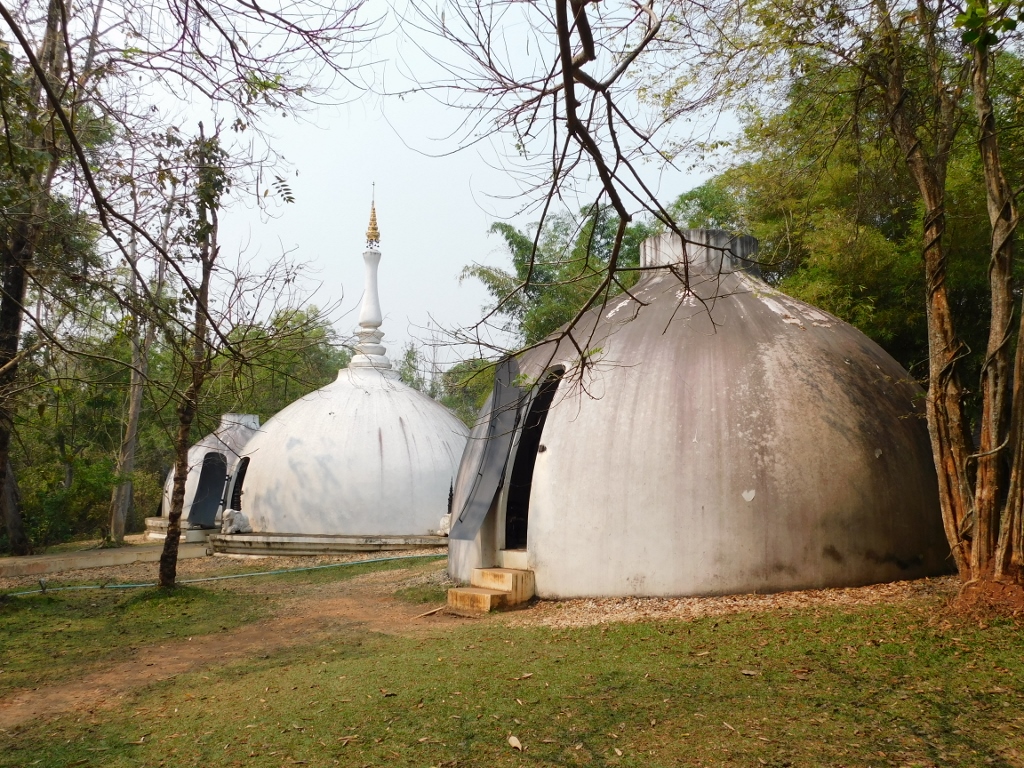 The Baandam Museum, three stupas
The Baandam Museum, three stupas
Here, I could also see the south-western end of the estate where there is a small pond, but with the limited time, I didn’t linger here for long. Instead, I headed towards the museum exit, passing by more interesting structures along the way.
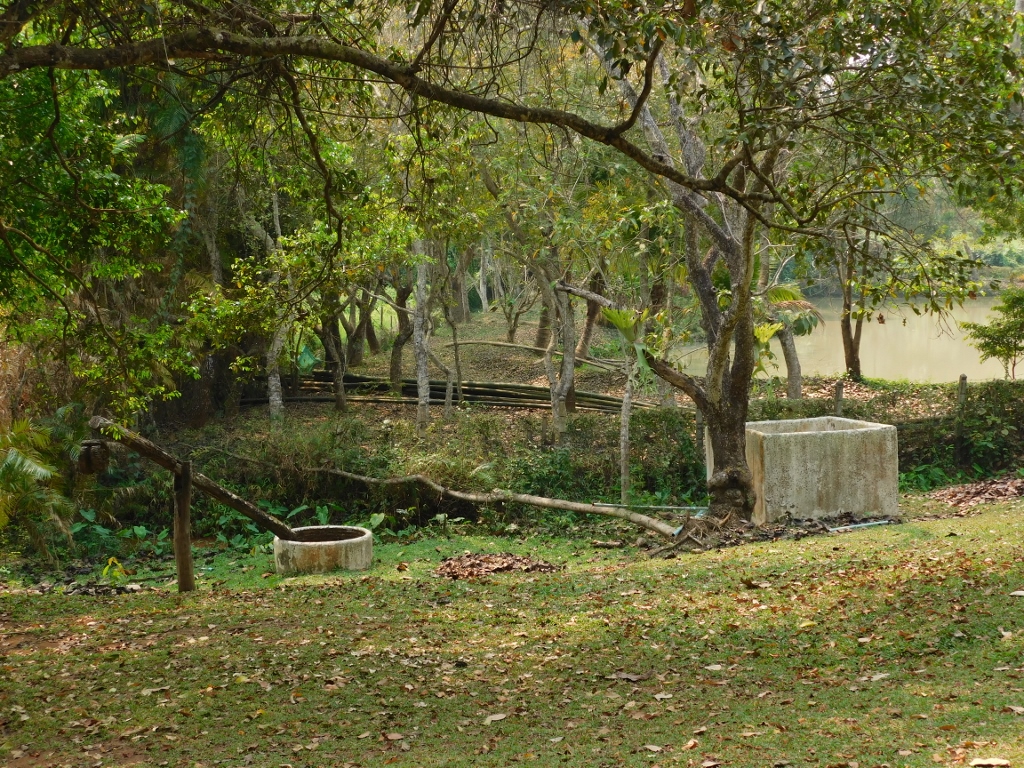 The Baandam Museum
The Baandam Museum
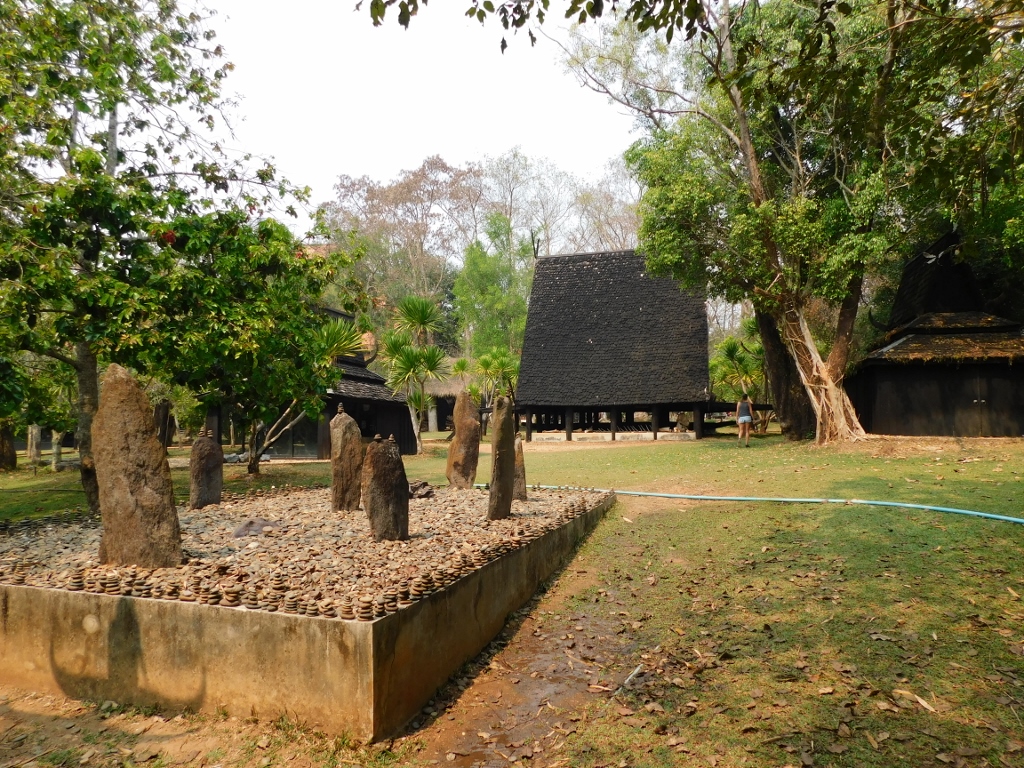 The Baandam Museum
The Baandam Museum
In the previous photo, another platform with arranged stones can be seen. Further ahead, towards the centre, the black roof of the structure called the Triangle House is visible. It is also elevated on wooden supports, like a stilt house. However, the structure on the far right in the photograph has the quirkiest name among all the museum objects – the Ten Thousand Birds Lavatory. Next to it, I came across a sign that clearly indicates the presence of separate toilets for women and men.
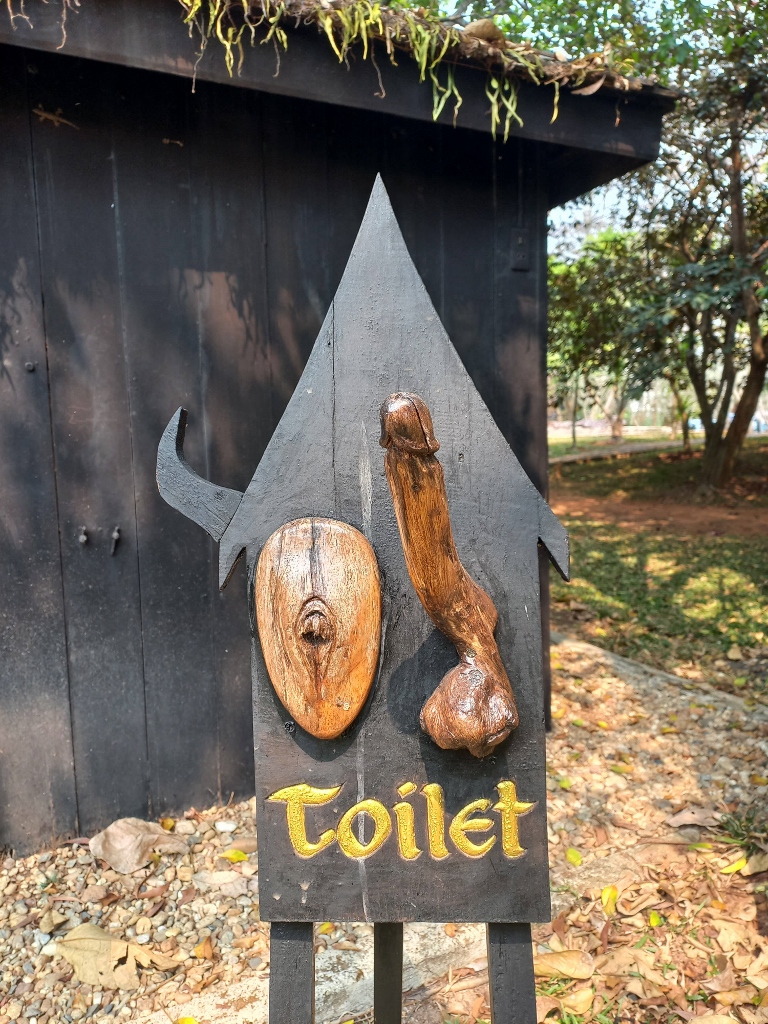 The Baandam Museum
The Baandam Museum
Equally intriguing is the name of the next structure I passed by, the Fish Trap House, although there were no picturesque signs here.
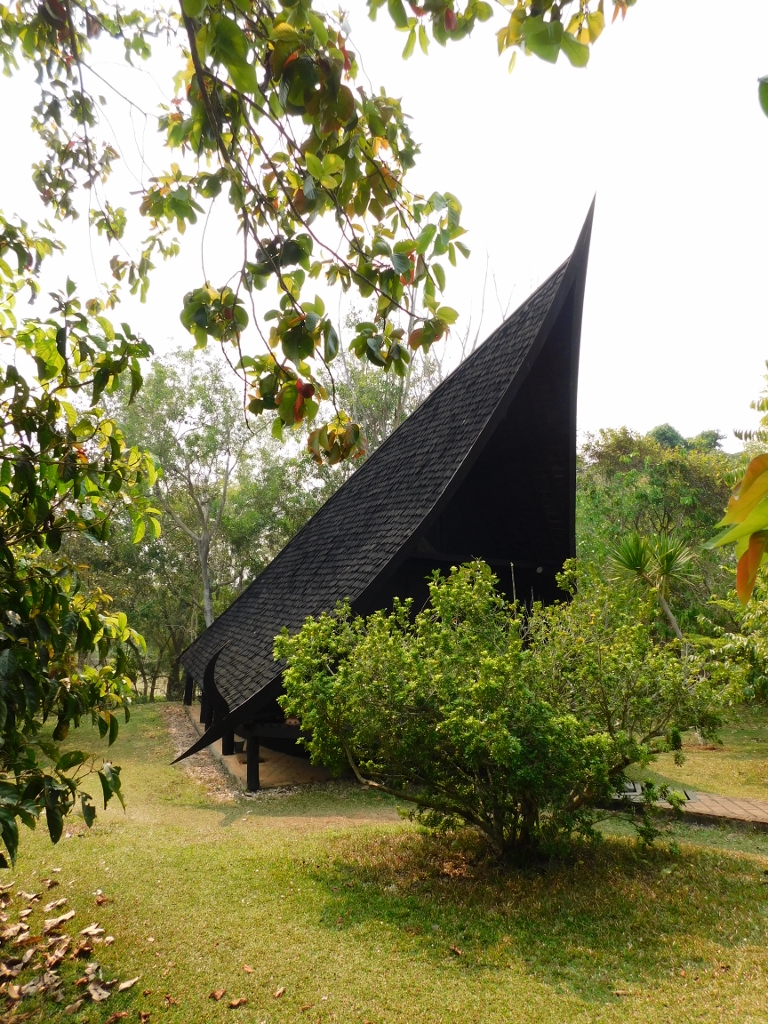 The Baandam Museum, Fish Trap House
The Baandam Museum, Fish Trap House
By this point, I definitely headed towards the exit, passing by three more structures along the way.
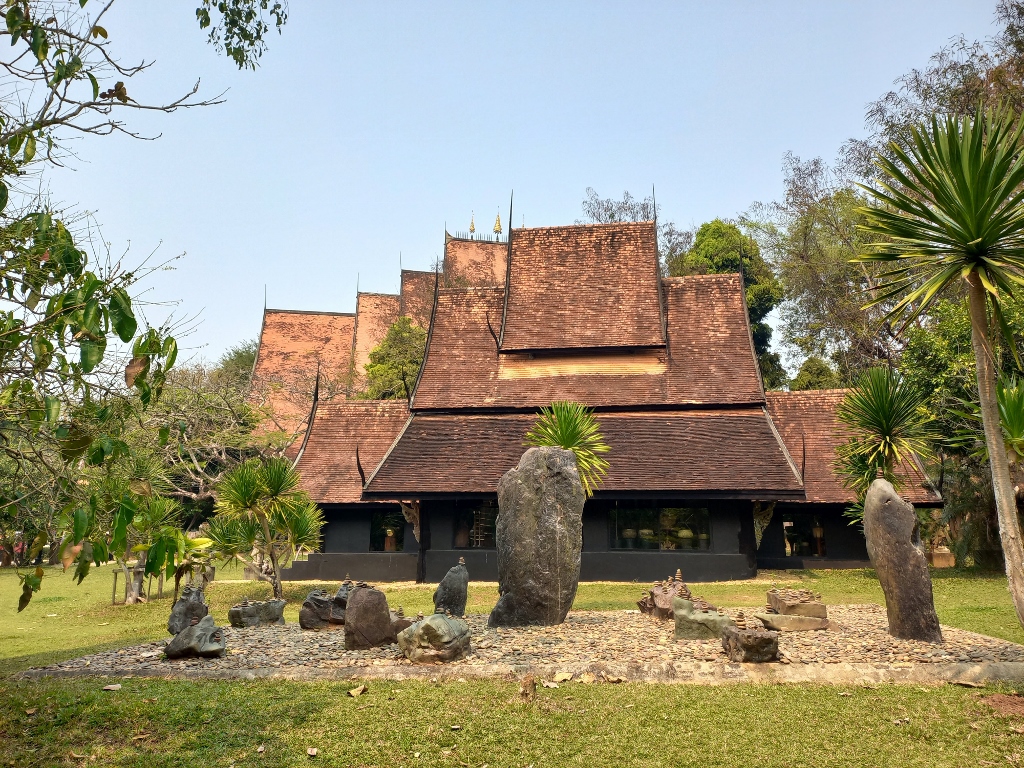 The Baandam Museum, Xieng Thong House
The Baandam Museum, Xieng Thong House
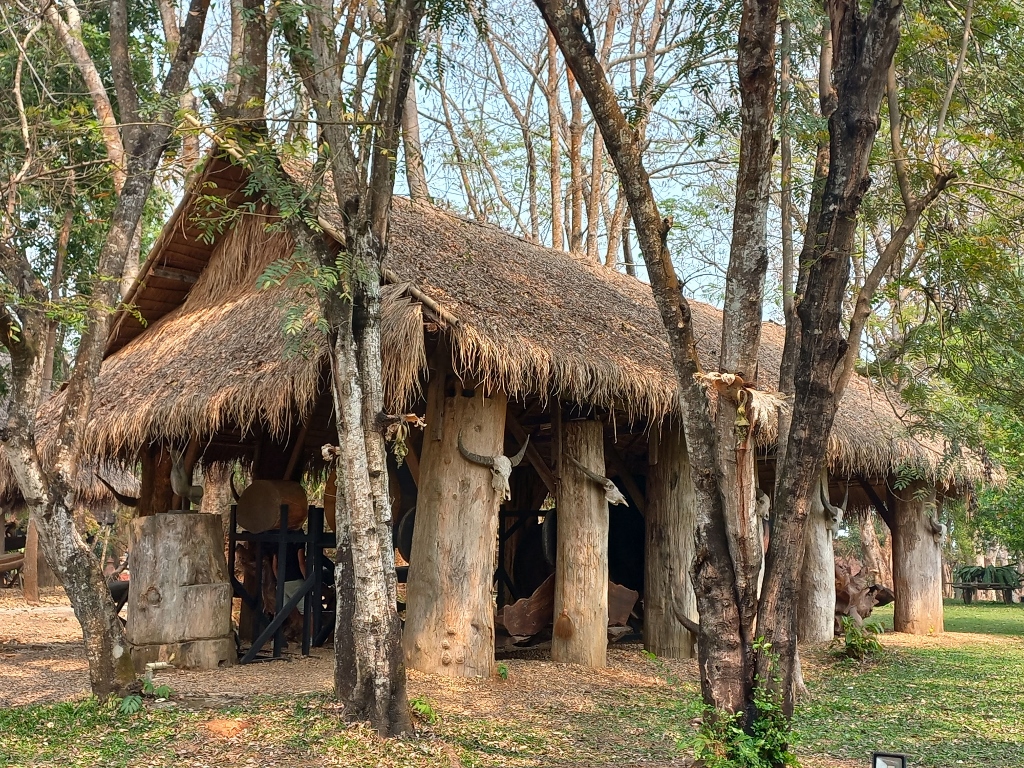 The Baandam Museum, Cottage of Time
The Baandam Museum, Cottage of Time
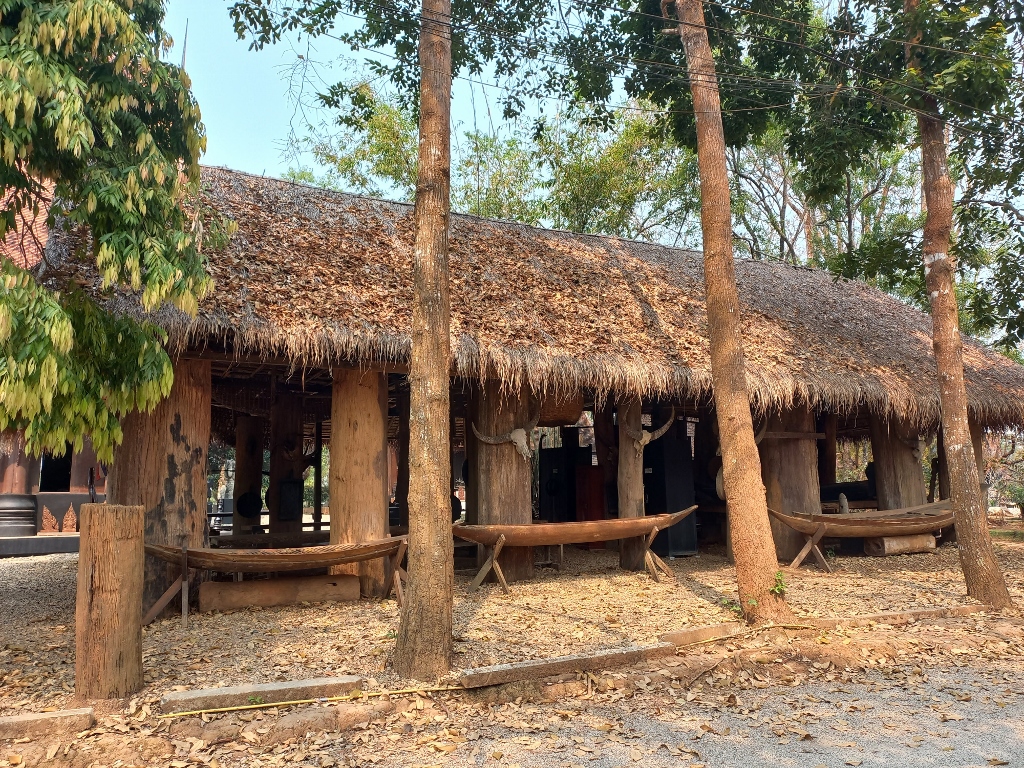 The Baandam Museum, Rest Shelter
The Baandam Museum, Rest Shelter
Having reached the main path, I took one last look and glanced over this exceptionally interesting and completely unique museum. I was thoroughly pleased.
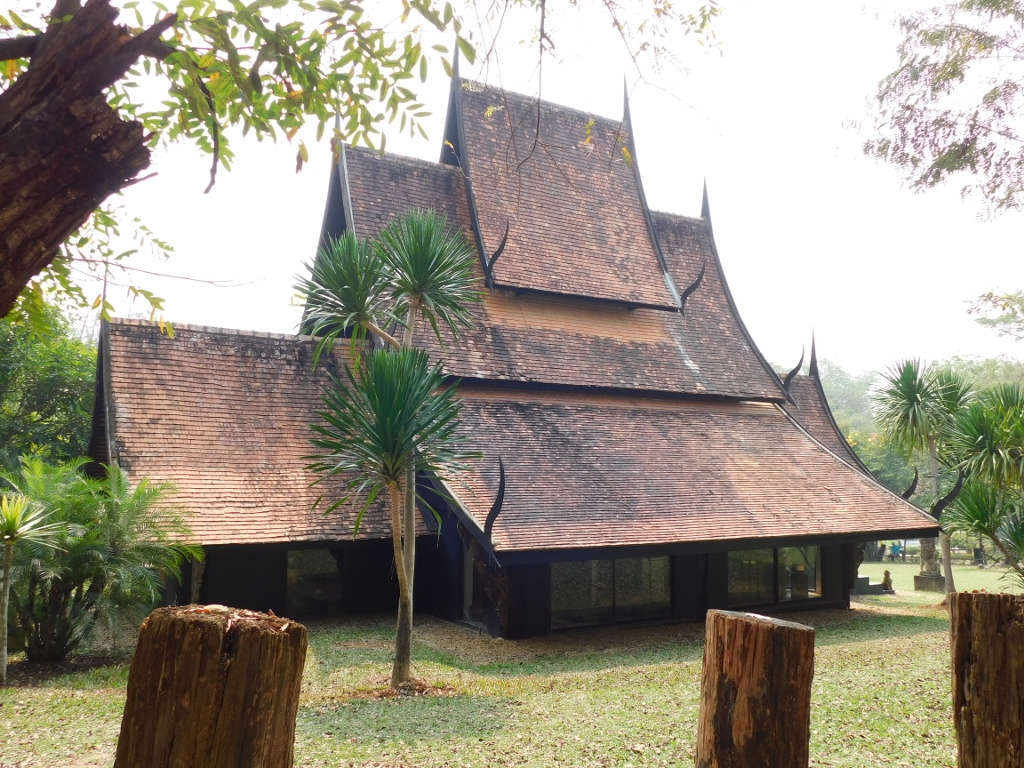 The Baandam Museum, Xieng Thong House
The Baandam Museum, Xieng Thong House
At the entrance/exit, I met with some group members since, after the initial information provided by the guide, everyone explored the museum at their own pace. While waiting for everyone to gather, I took a few more photos of the Sanctuary. Then, I went to a nearby store and bought something cold and refreshing. It was necessary before continuing the journey.
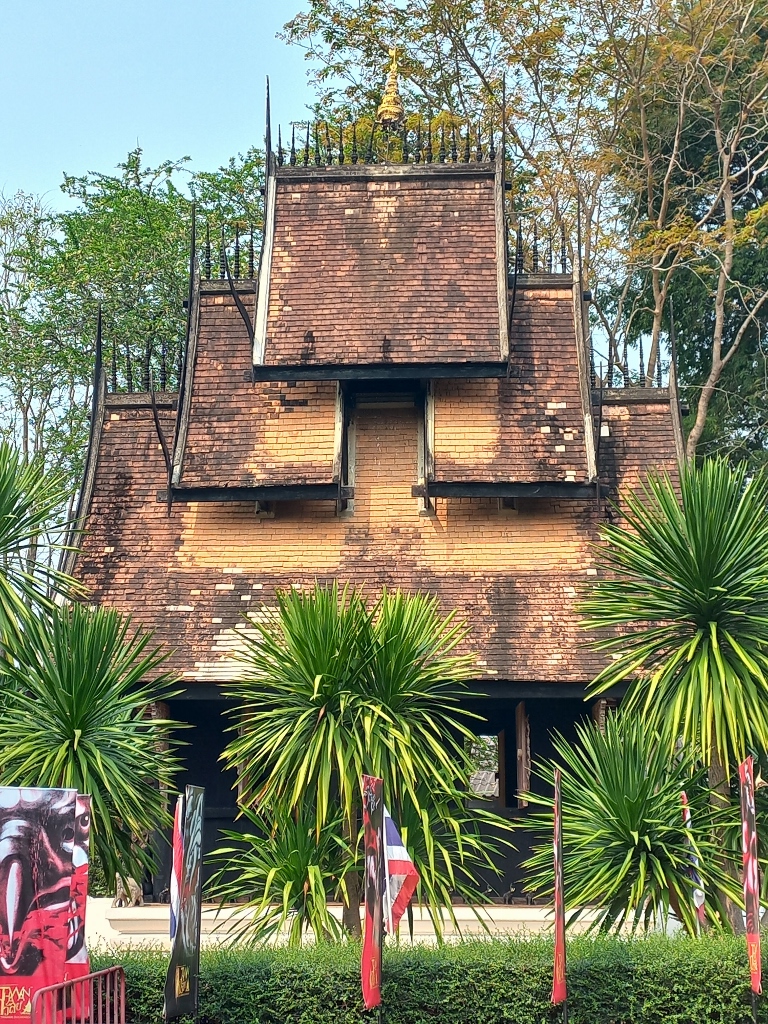 The Baandam Museum, Sanctuary, side view
The Baandam Museum, Sanctuary, side view
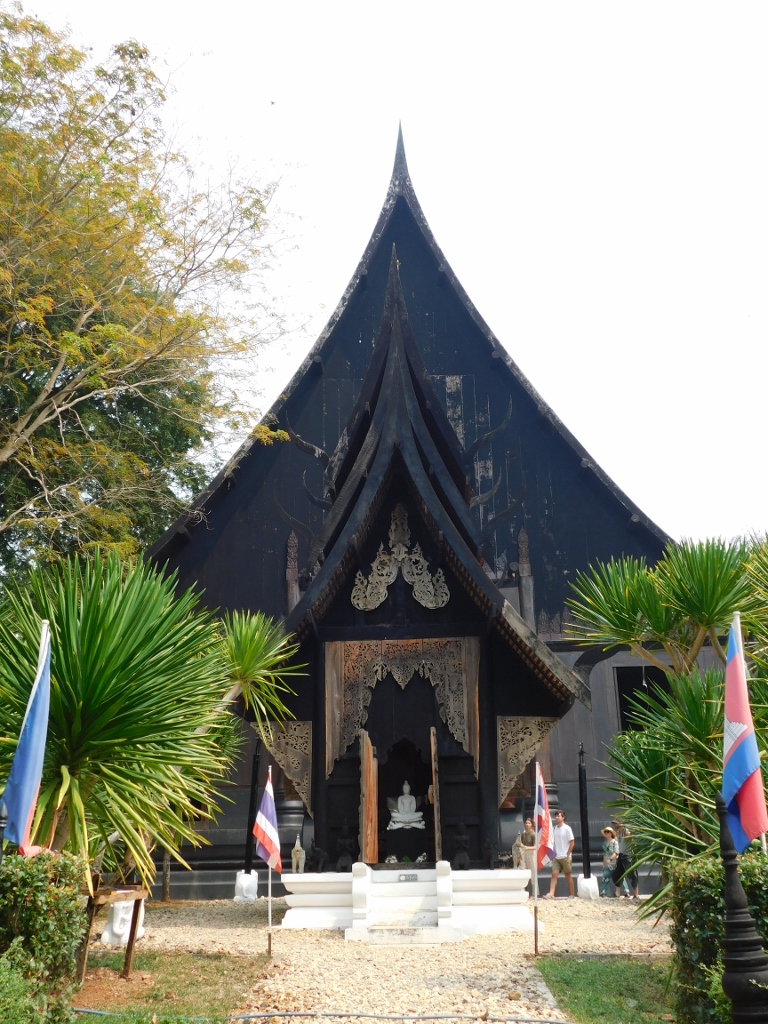 The Baandam Museum, Sanctuary, frontal view; behind is the imposing Main Sanctuary Hall
The Baandam Museum, Sanctuary, frontal view; behind is the imposing Main Sanctuary Hall